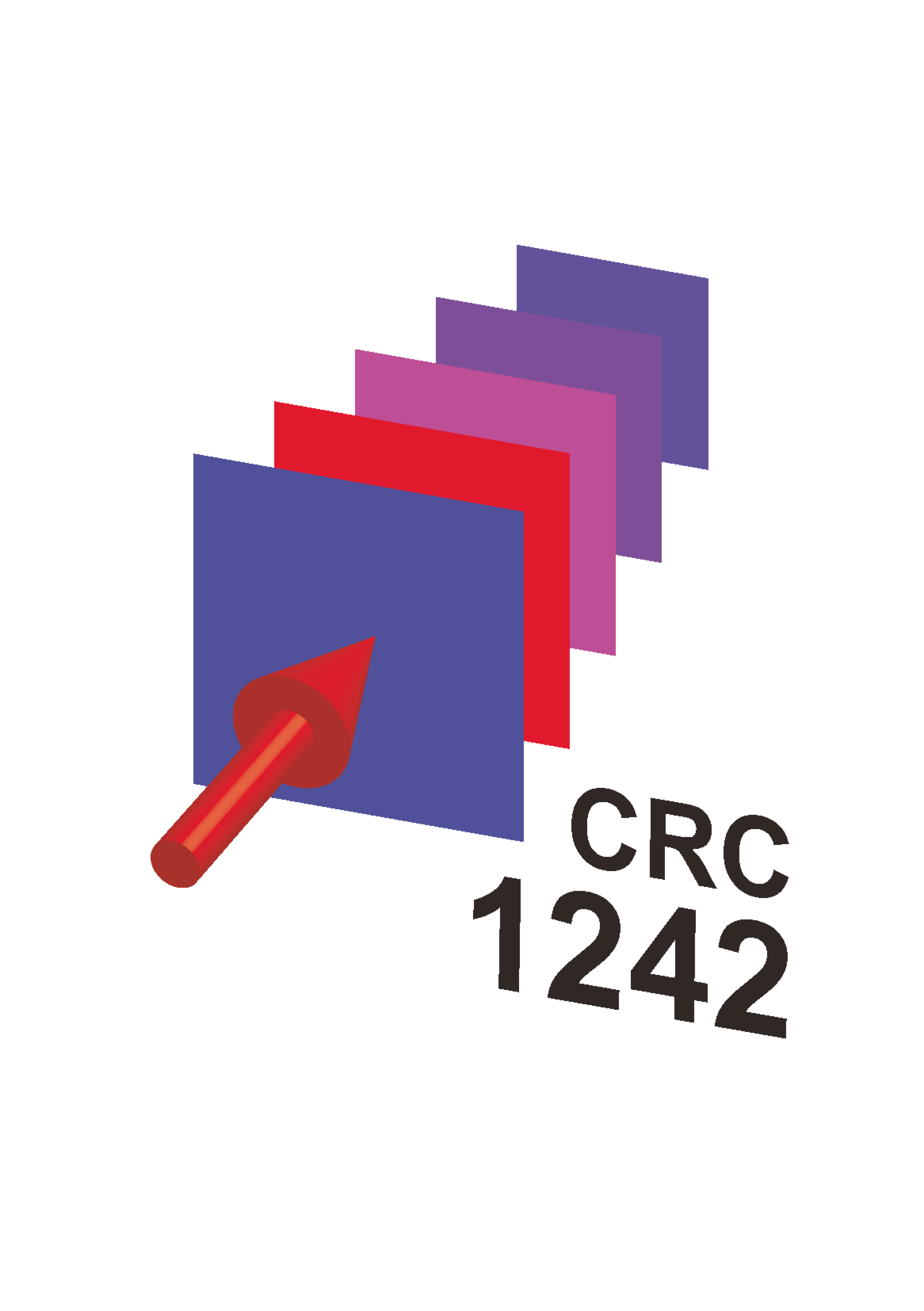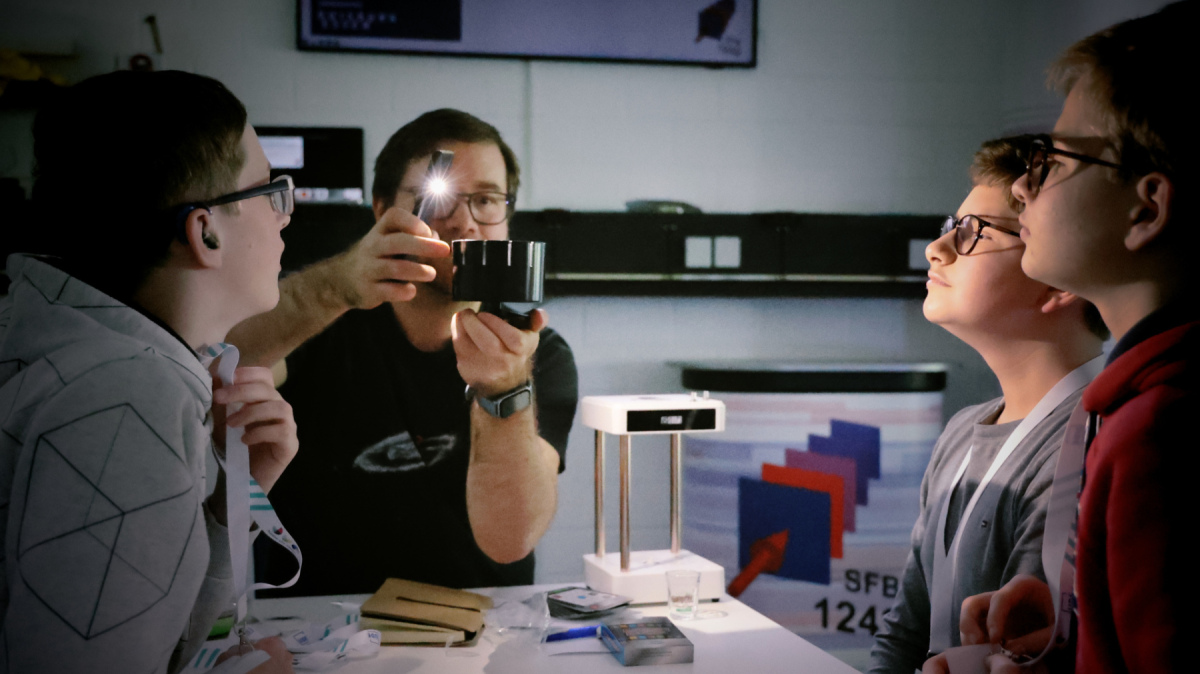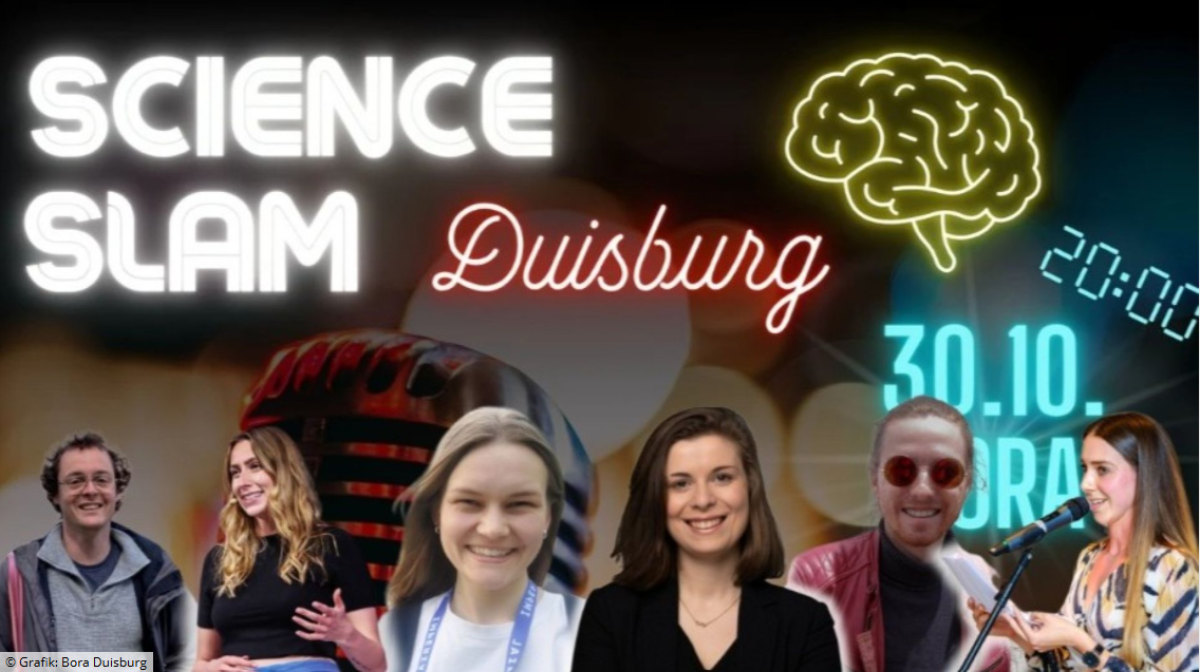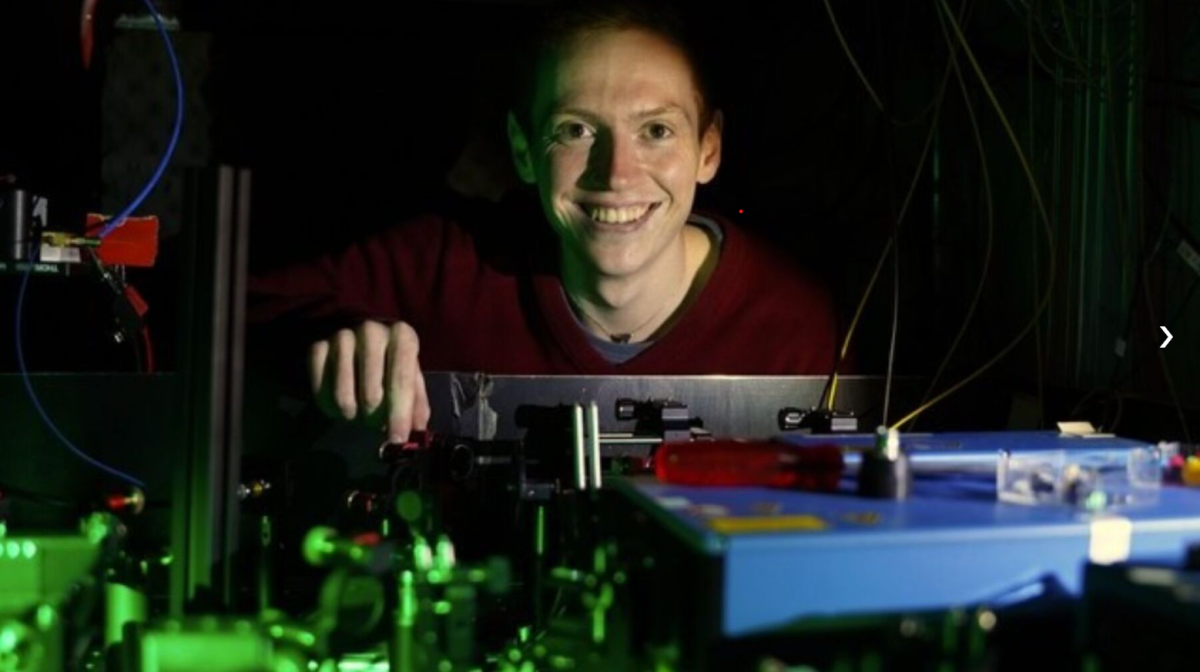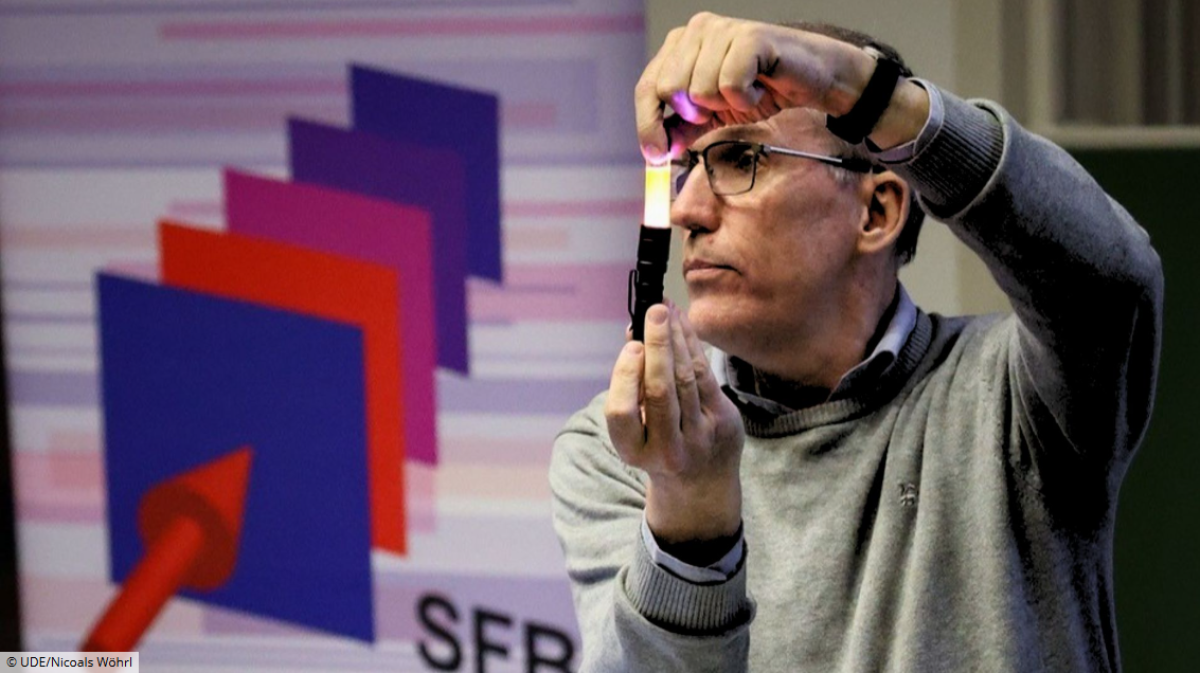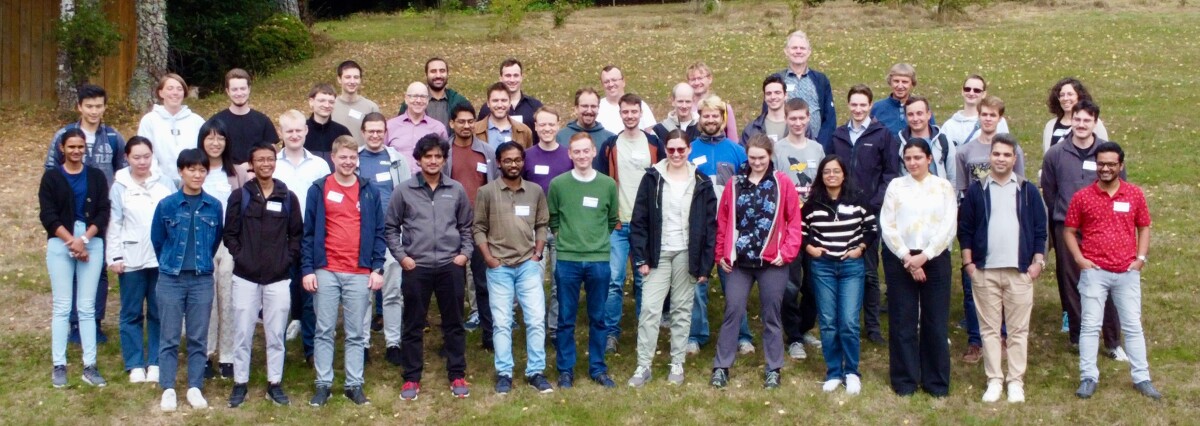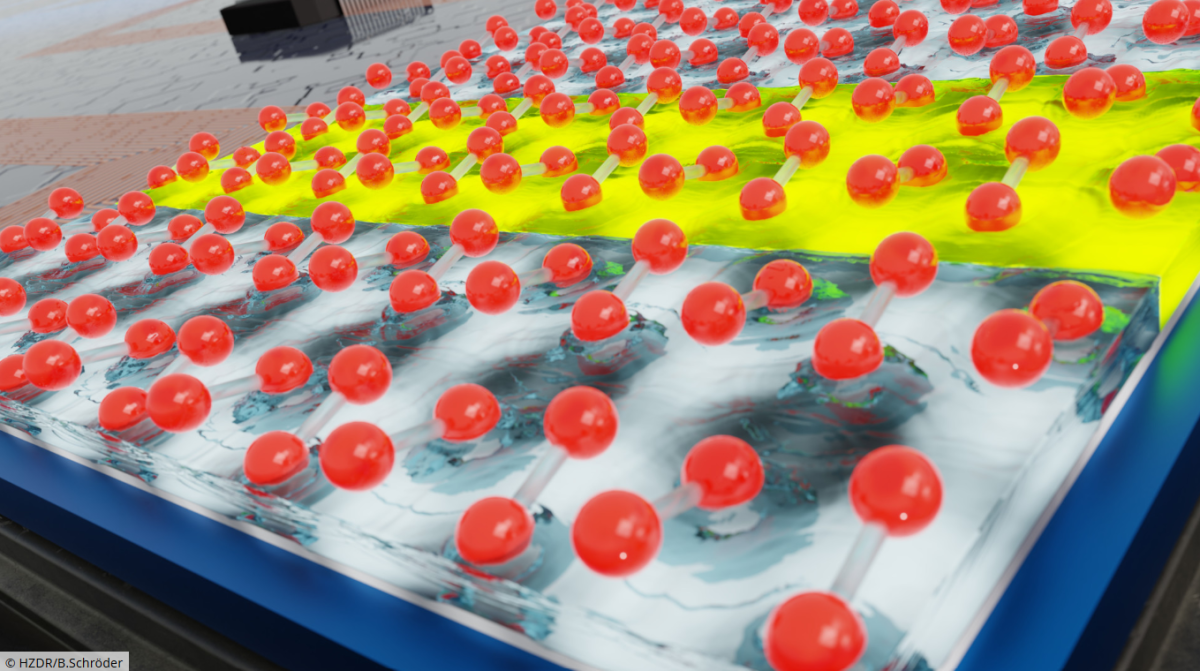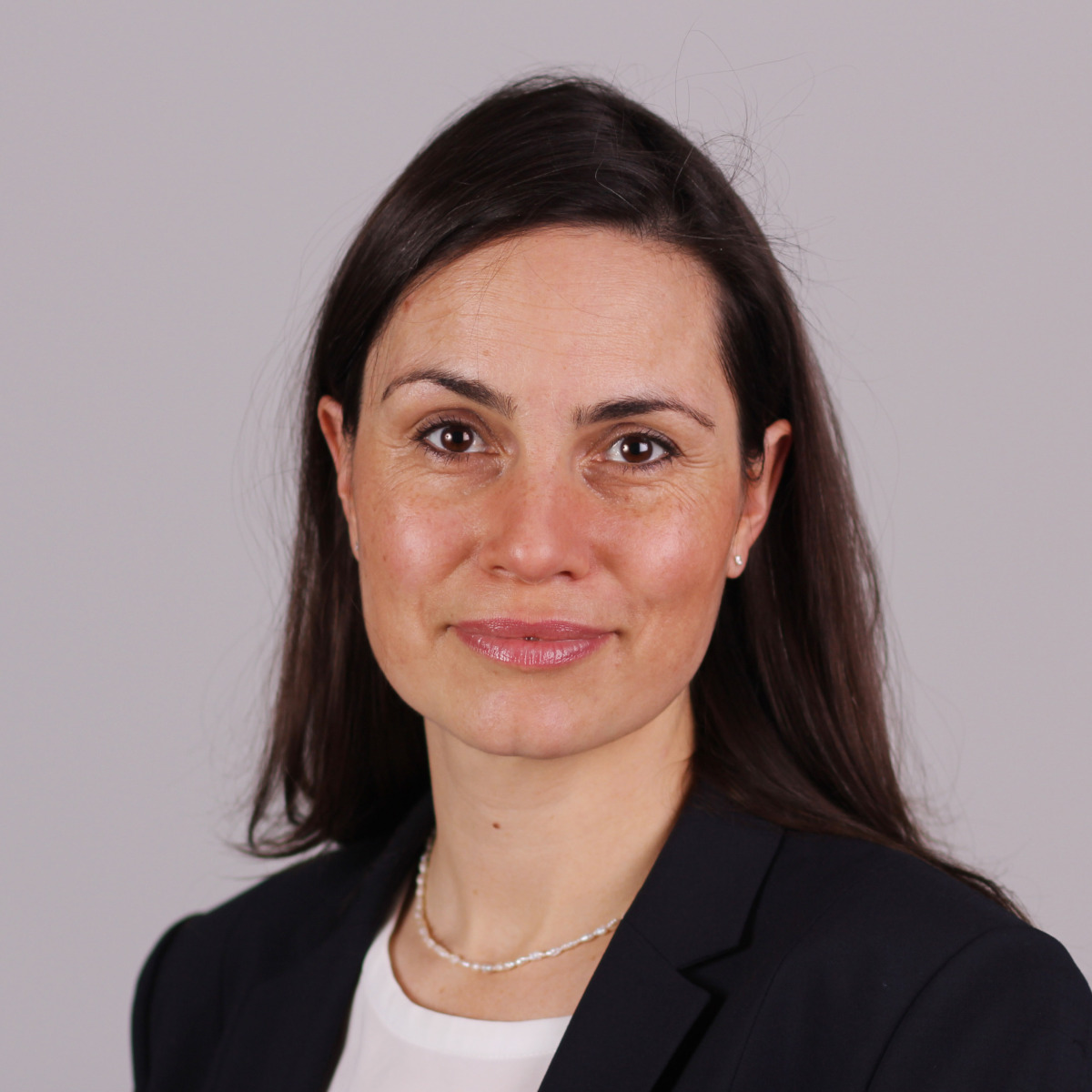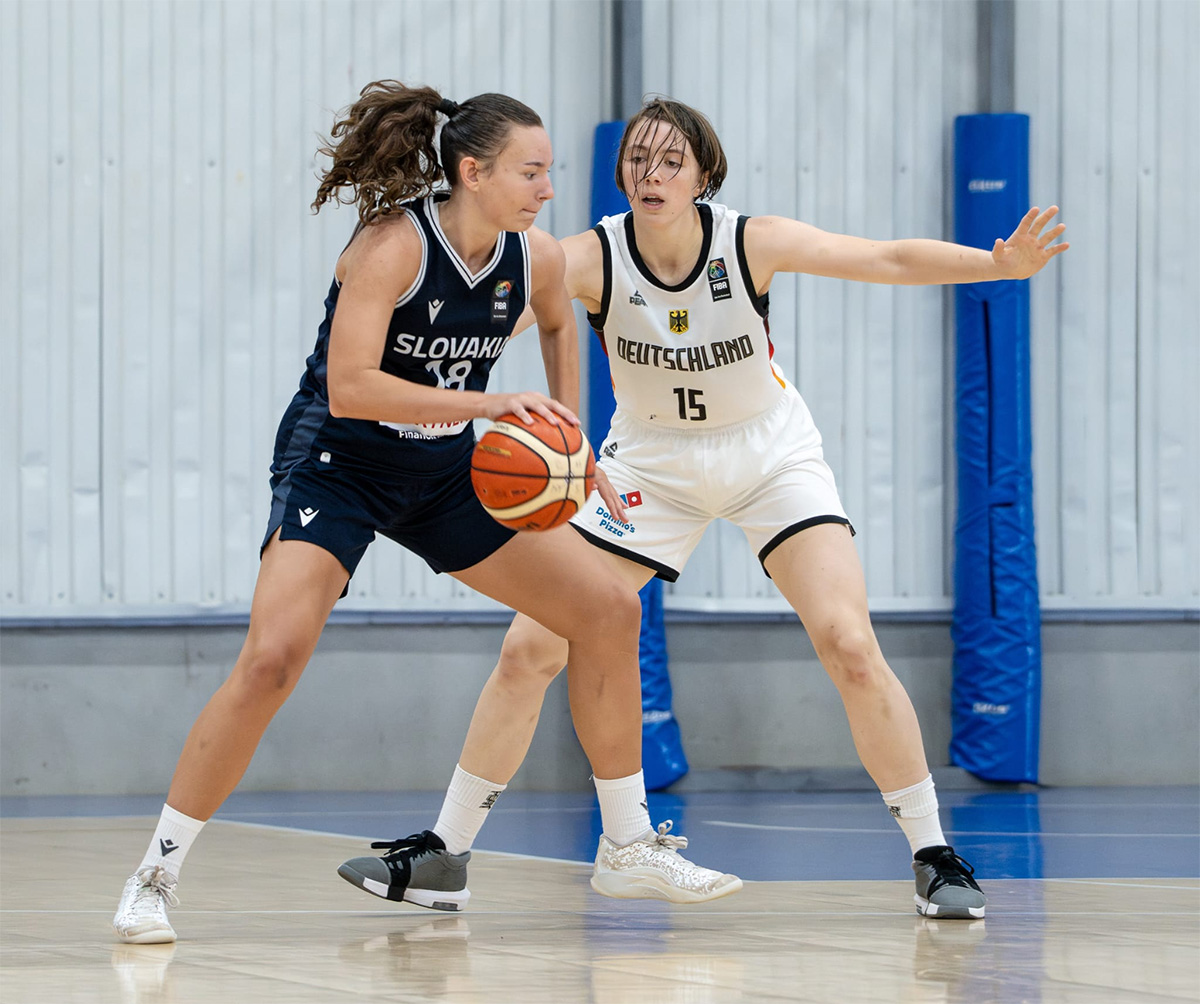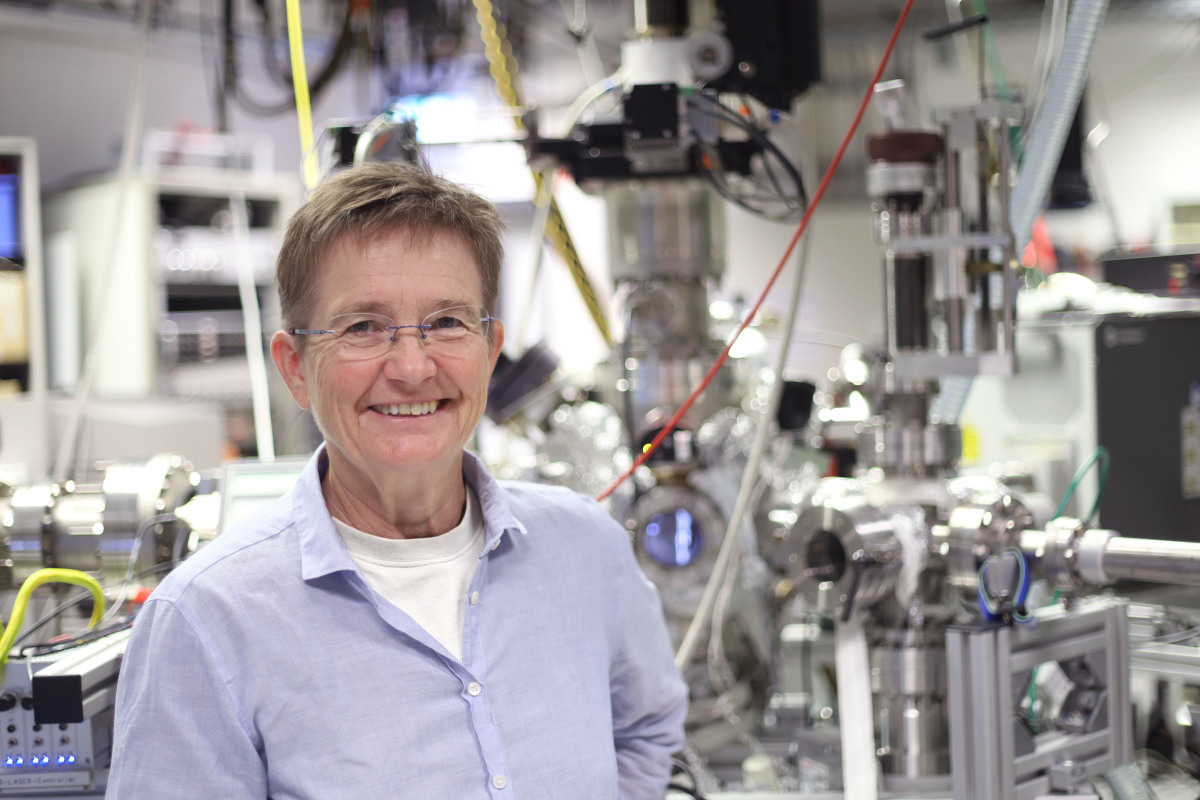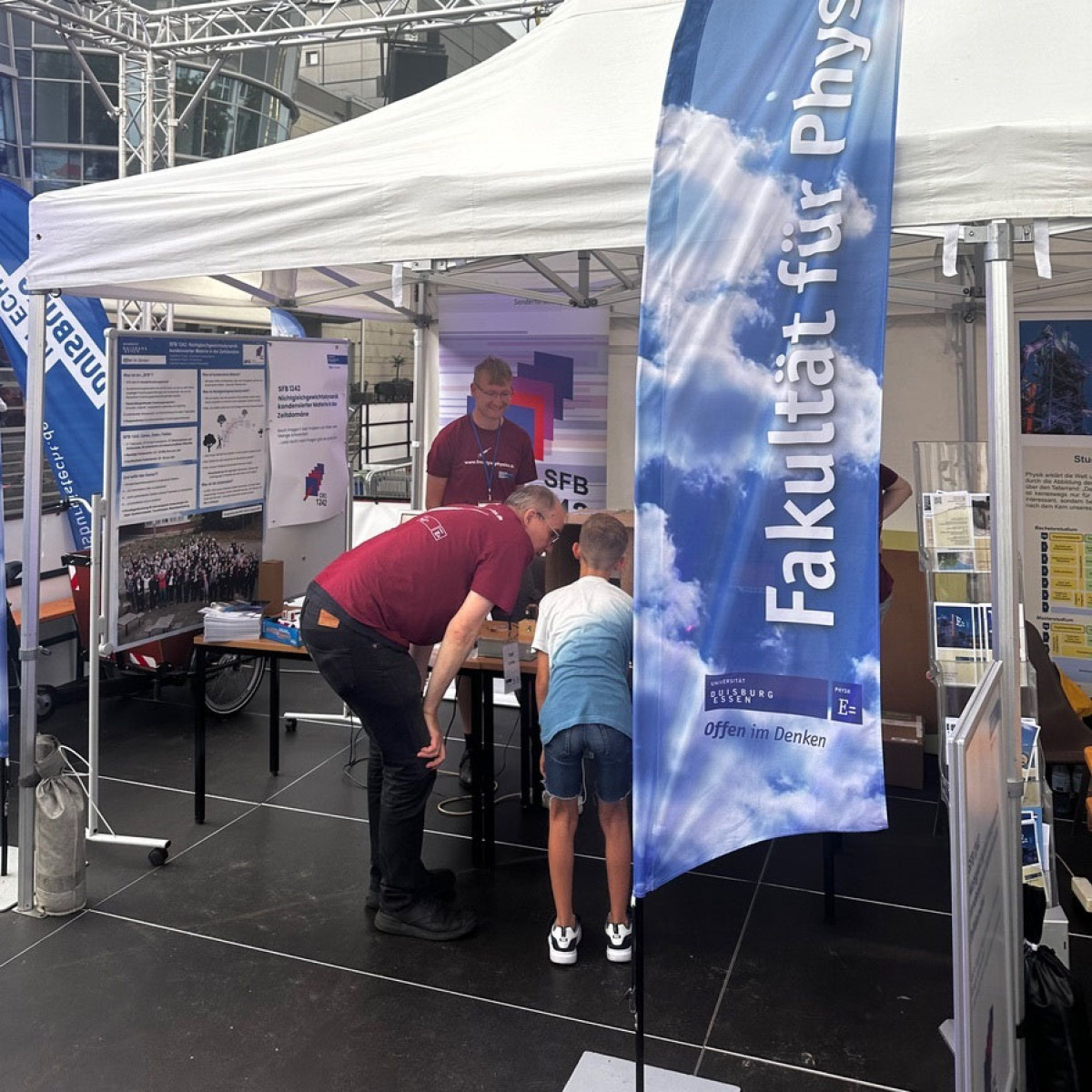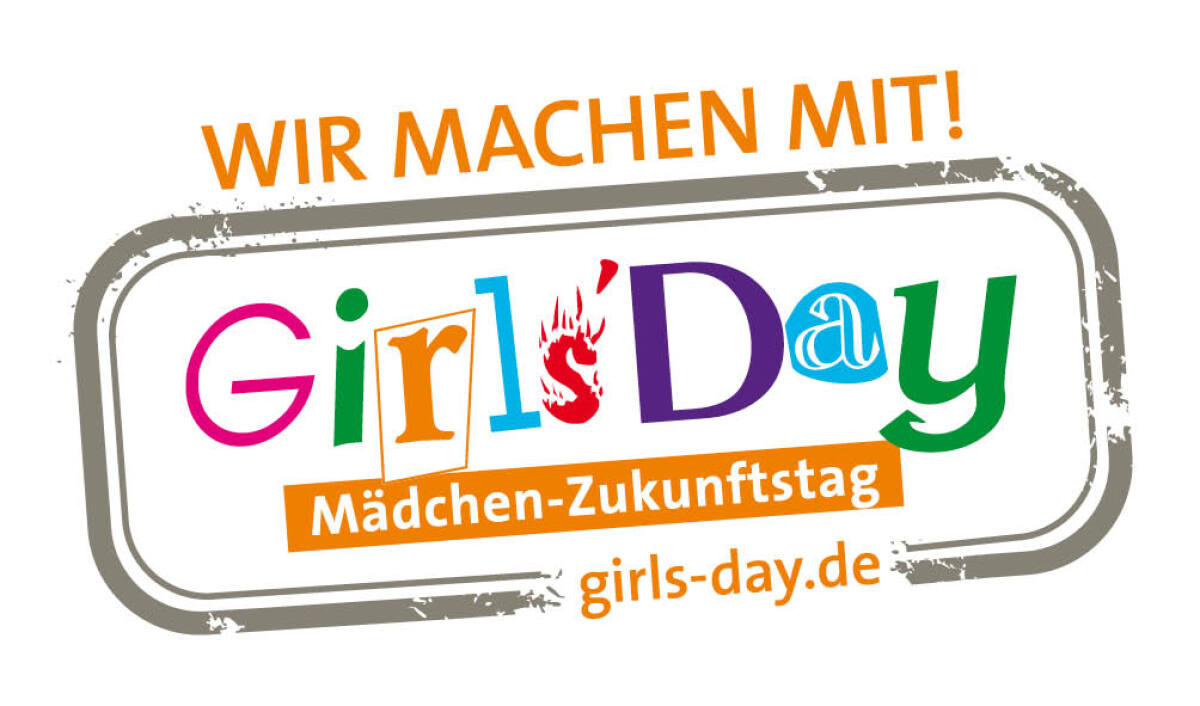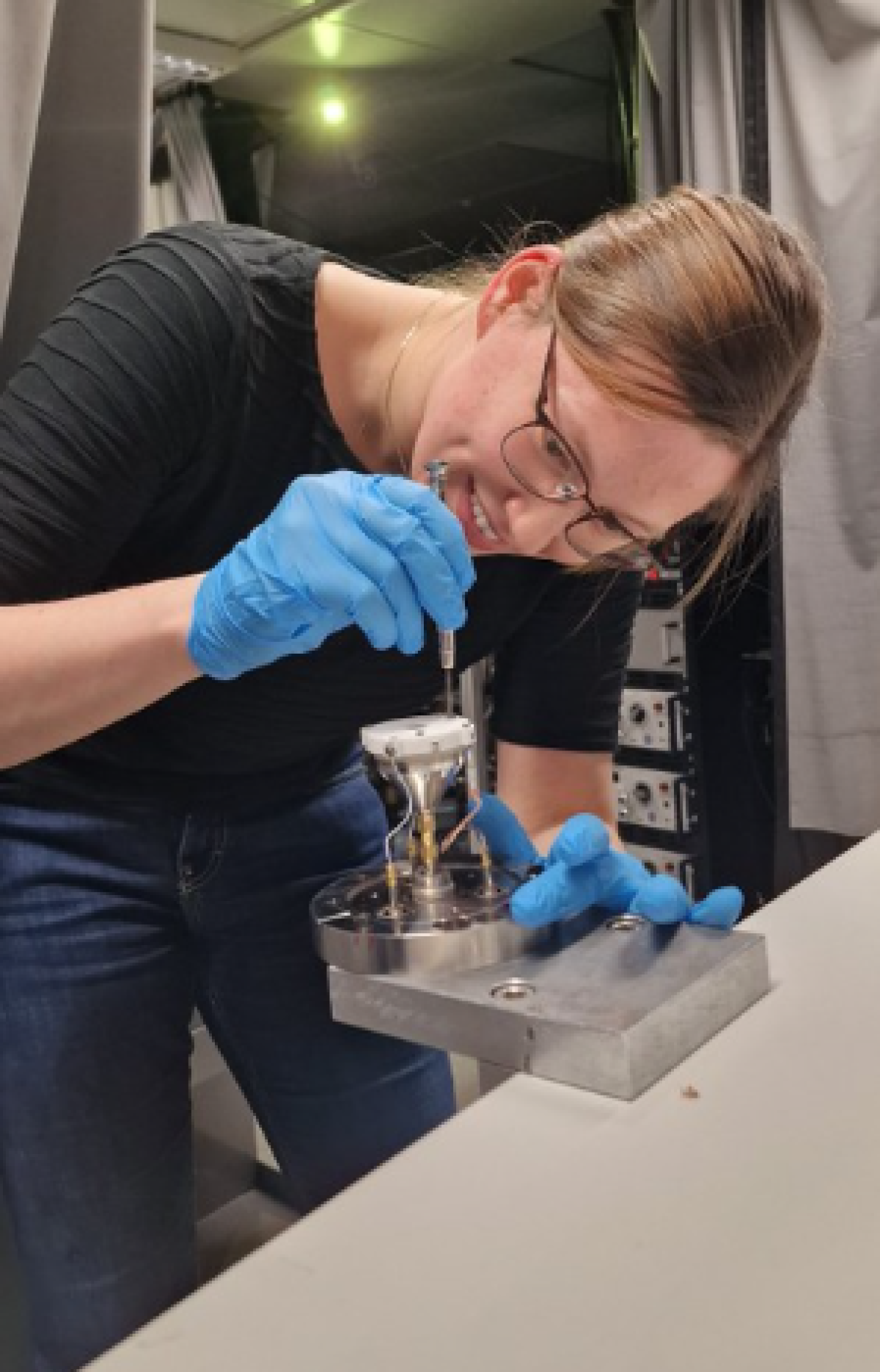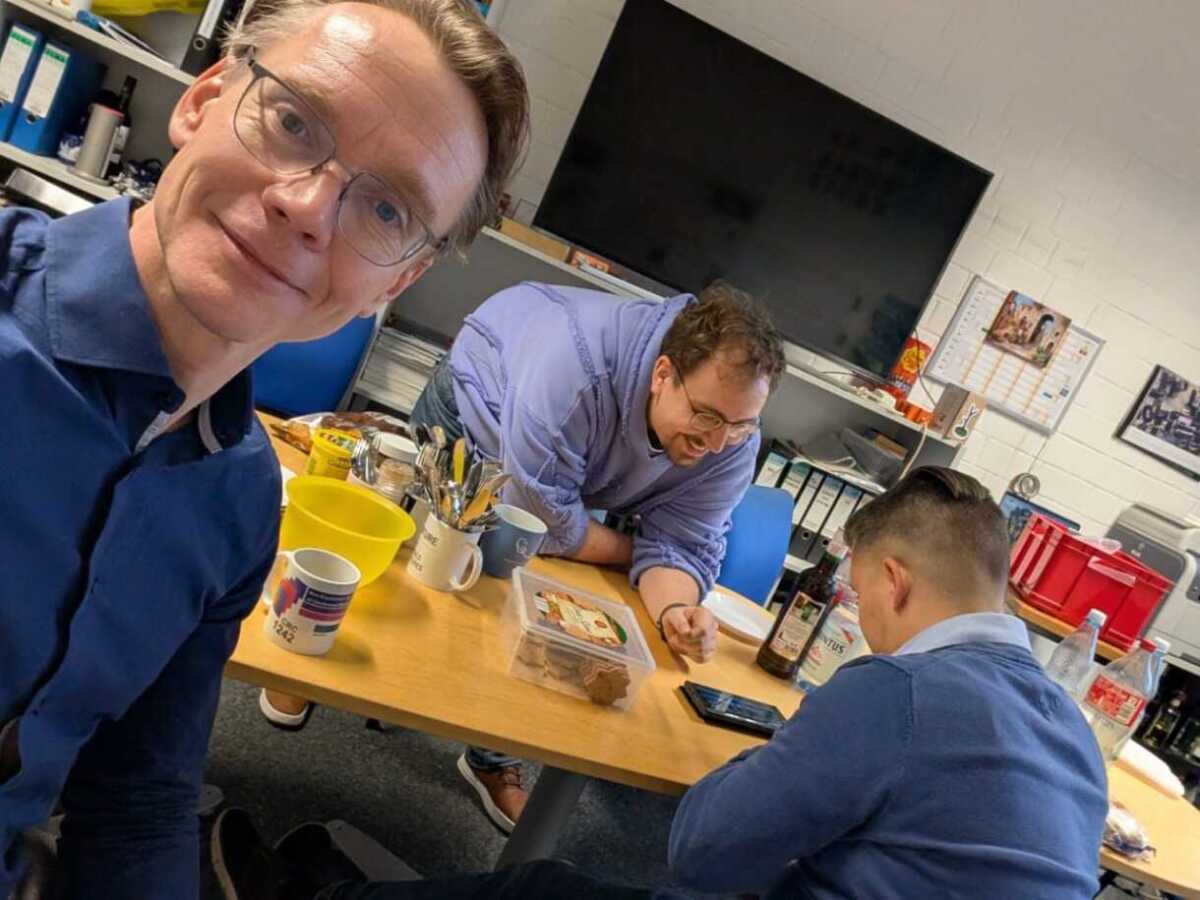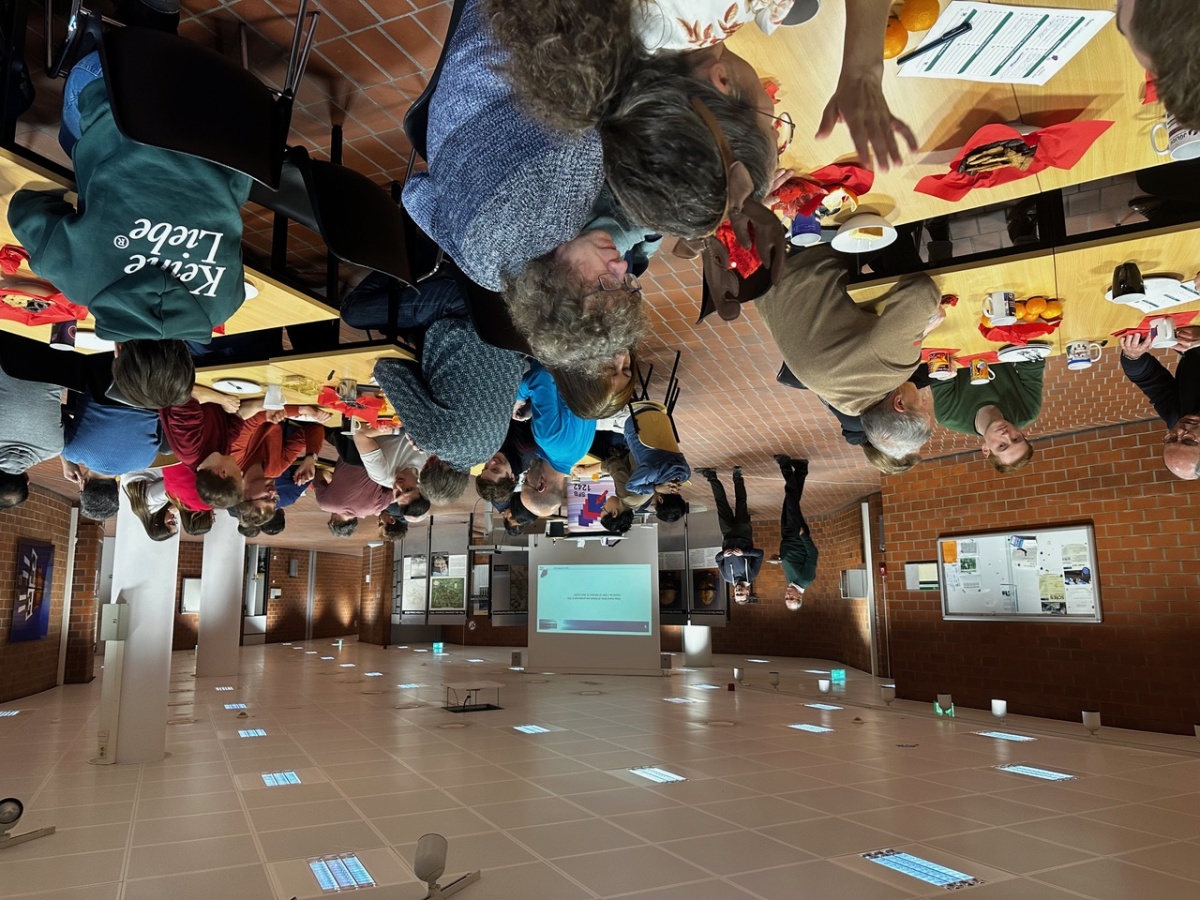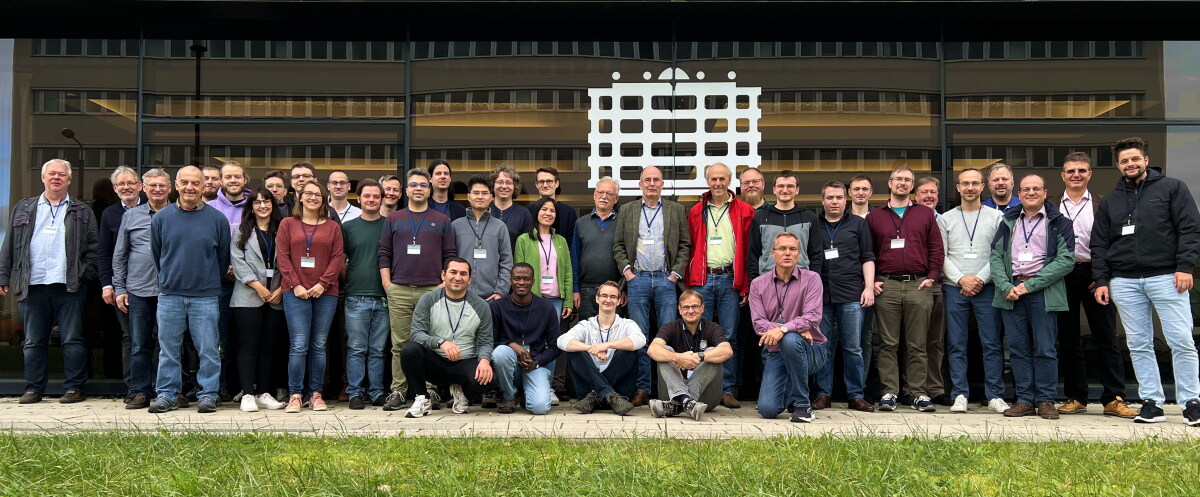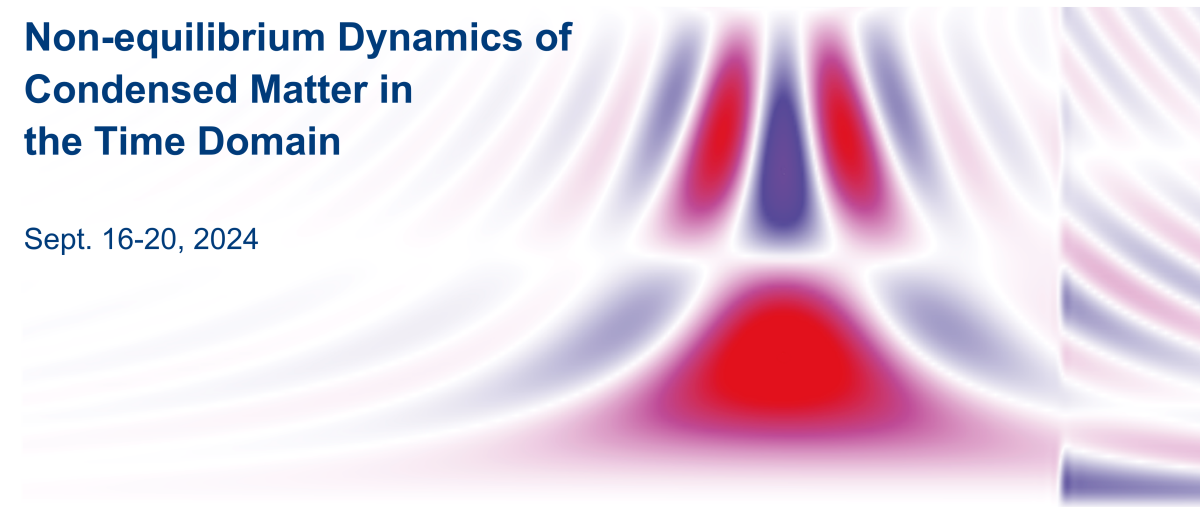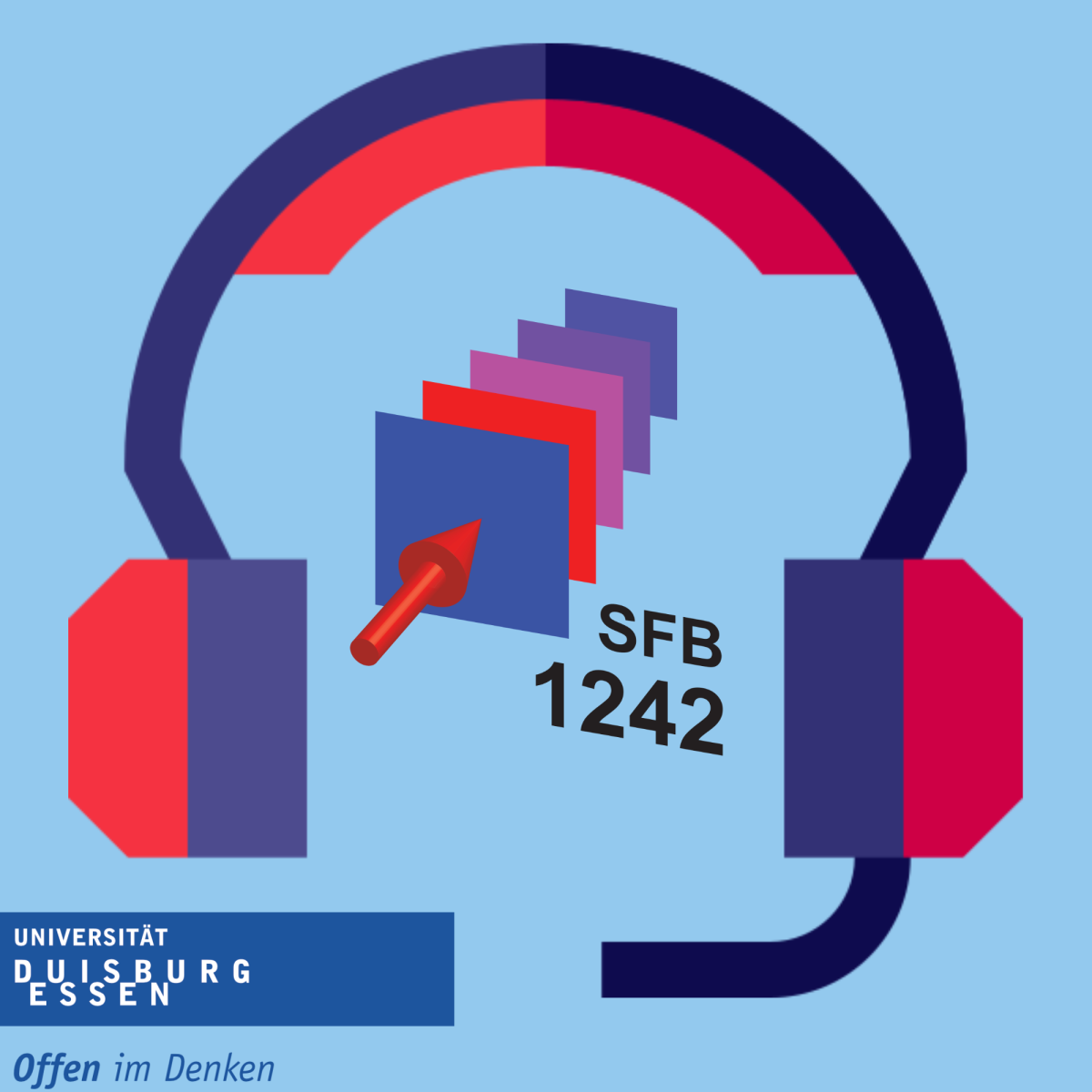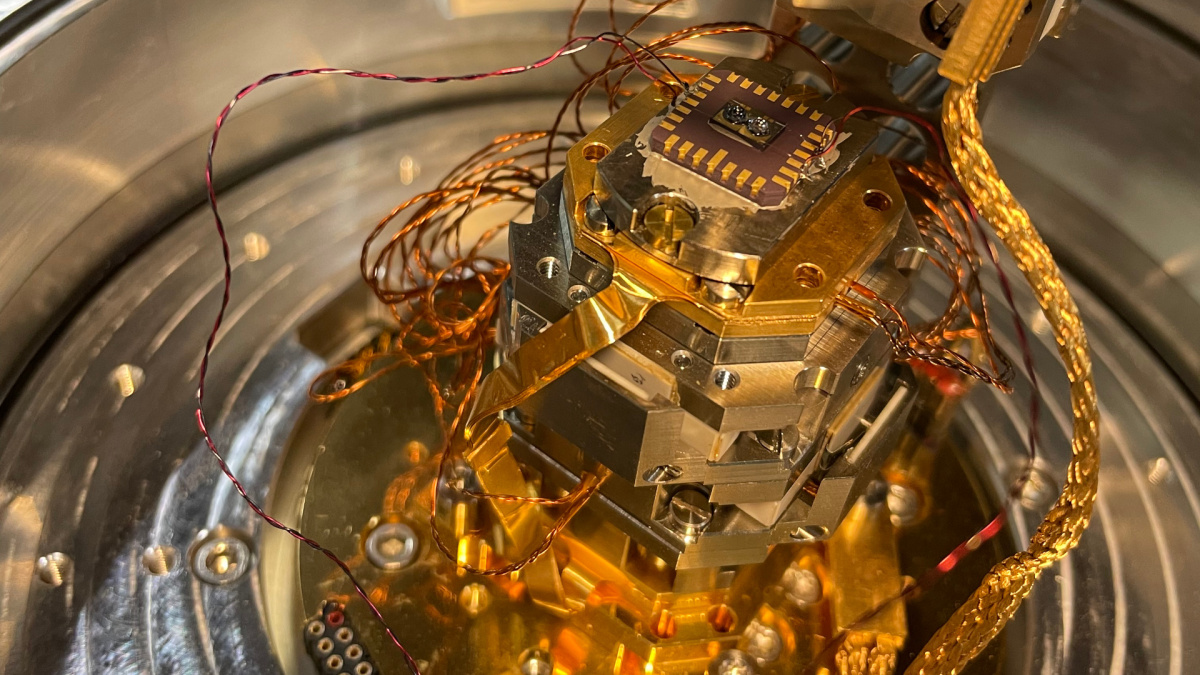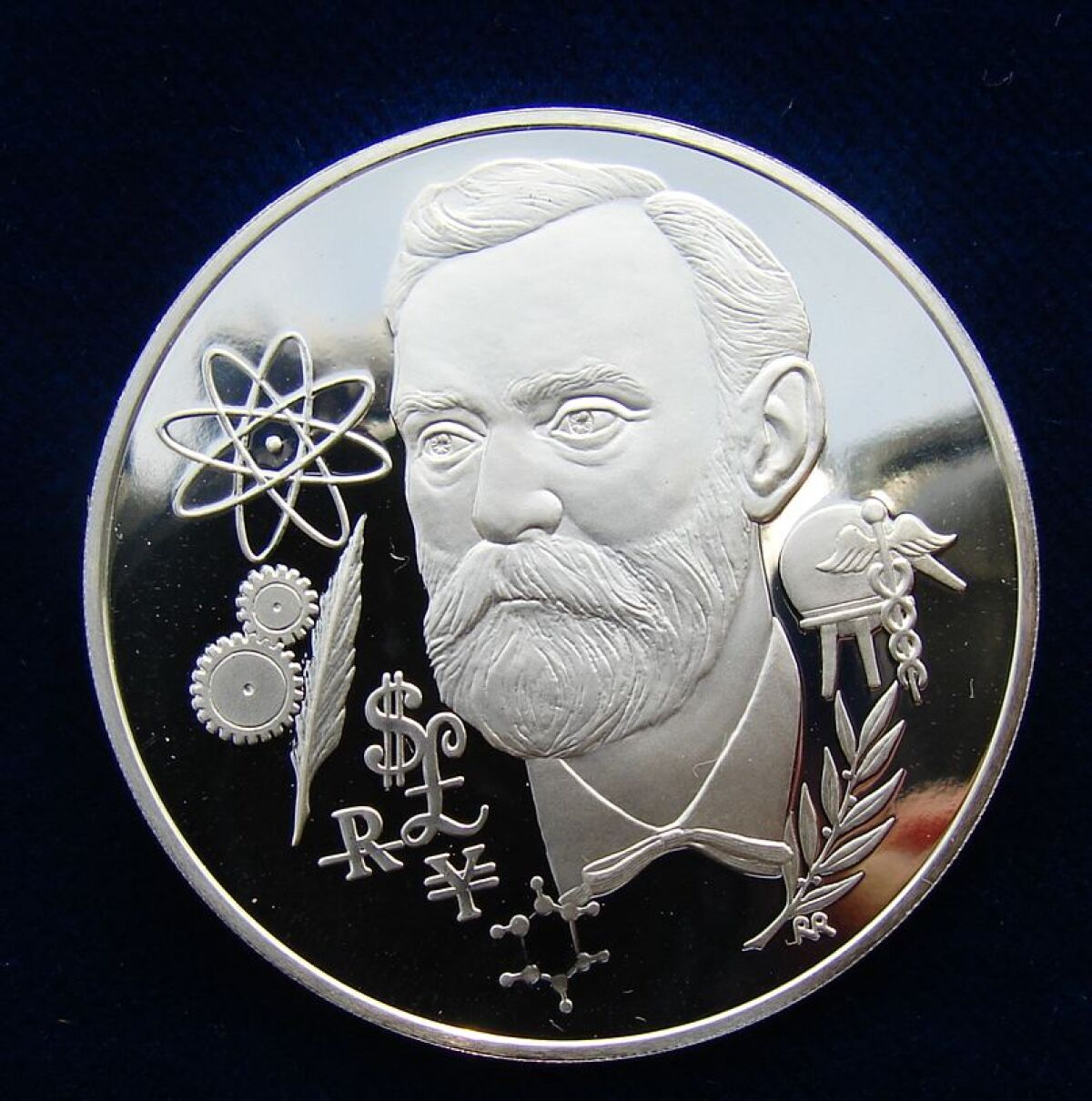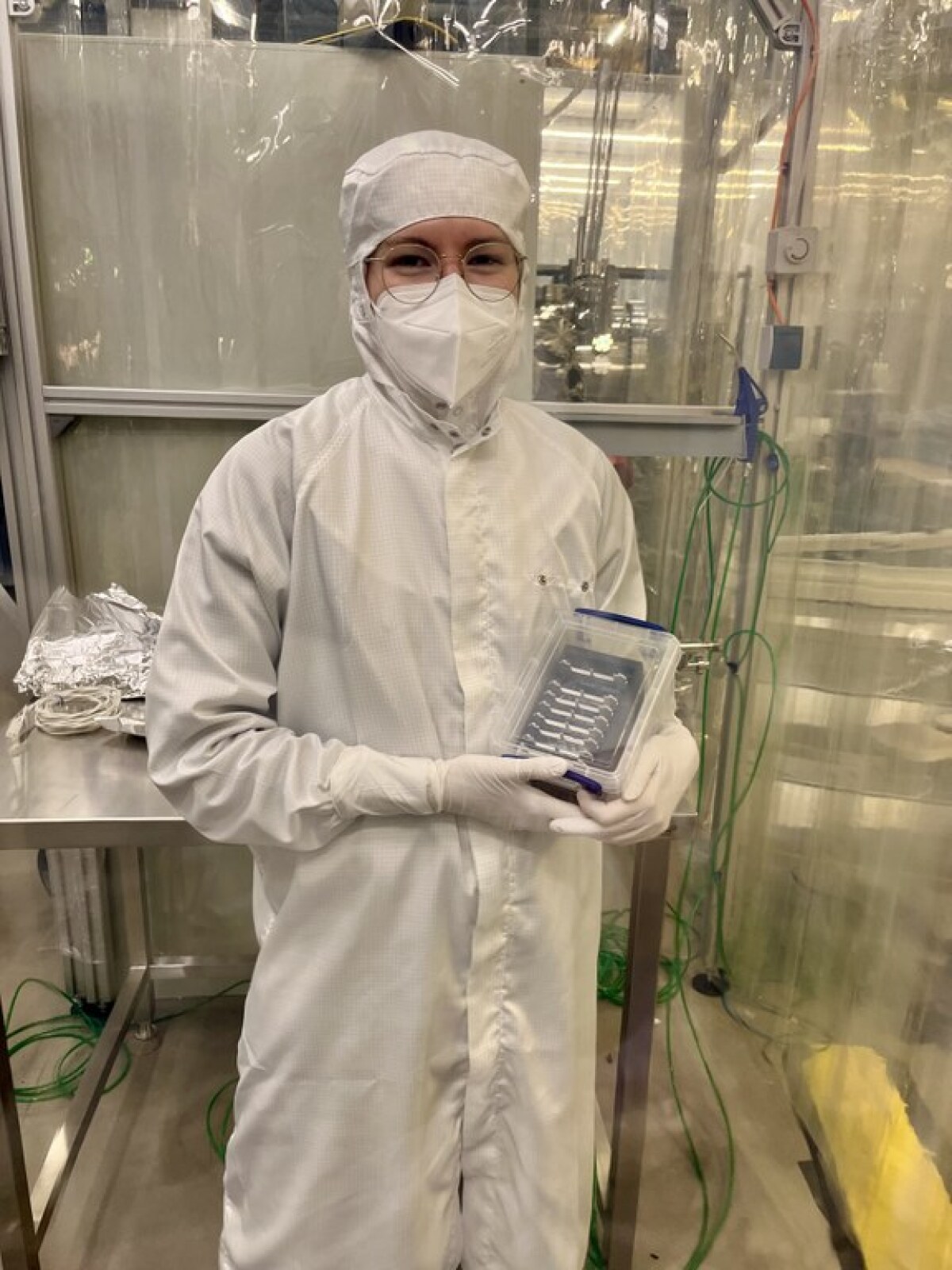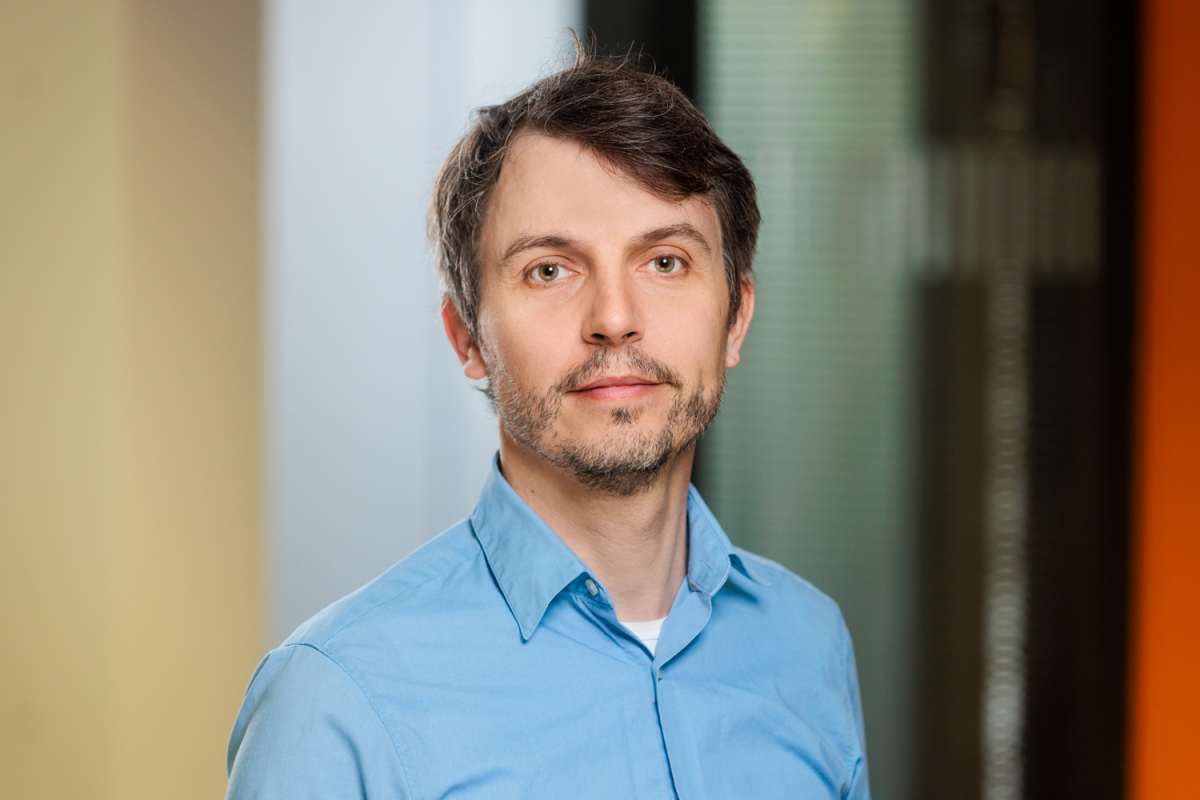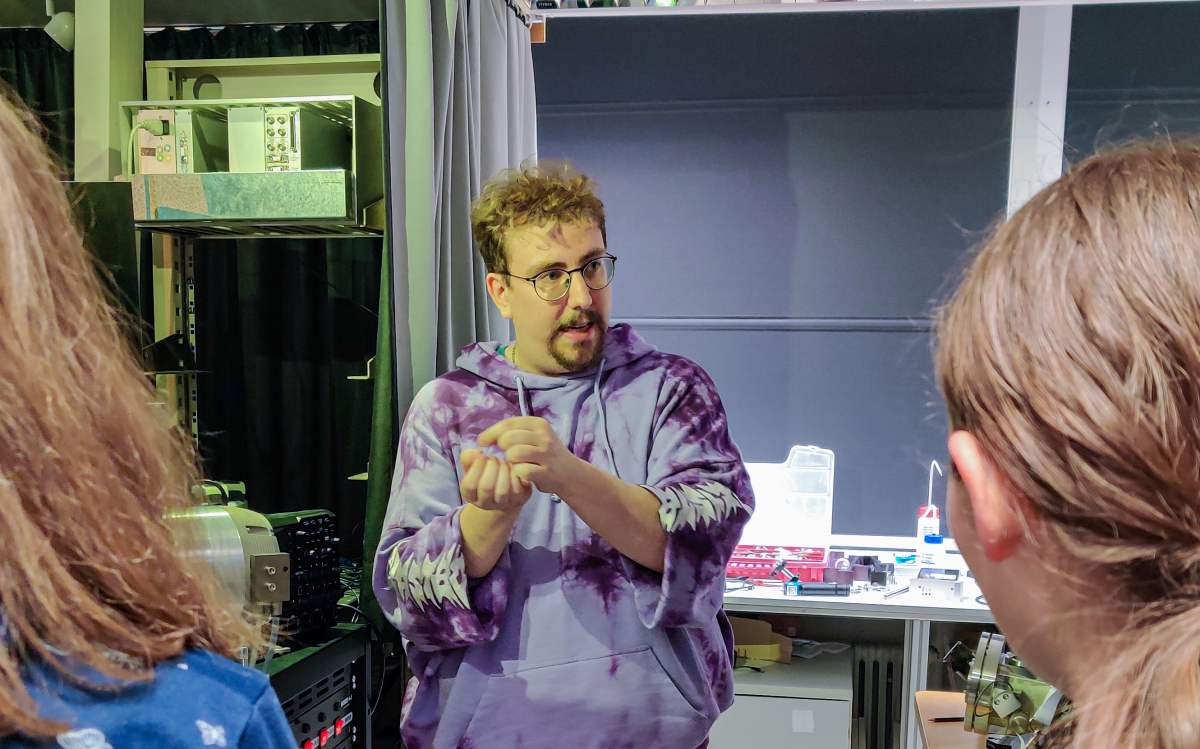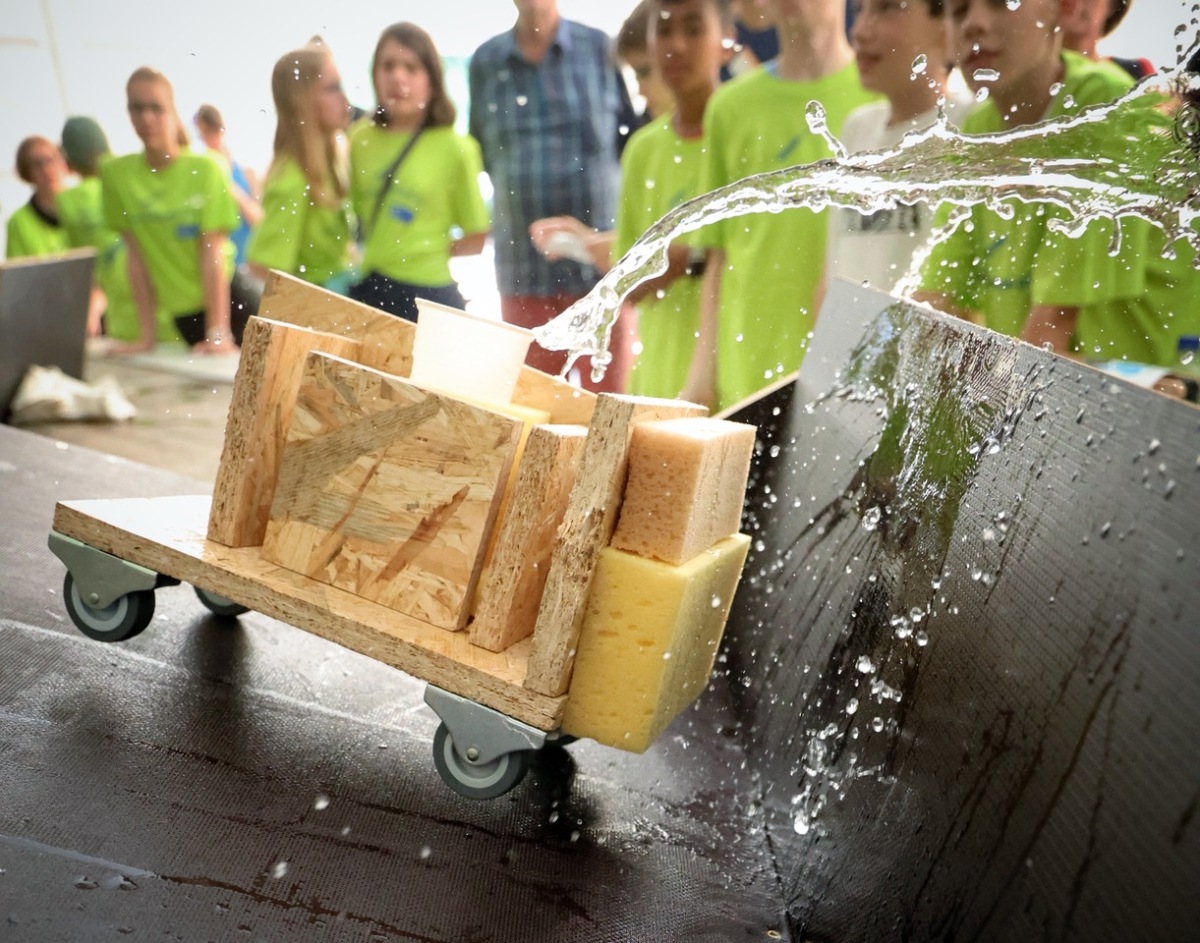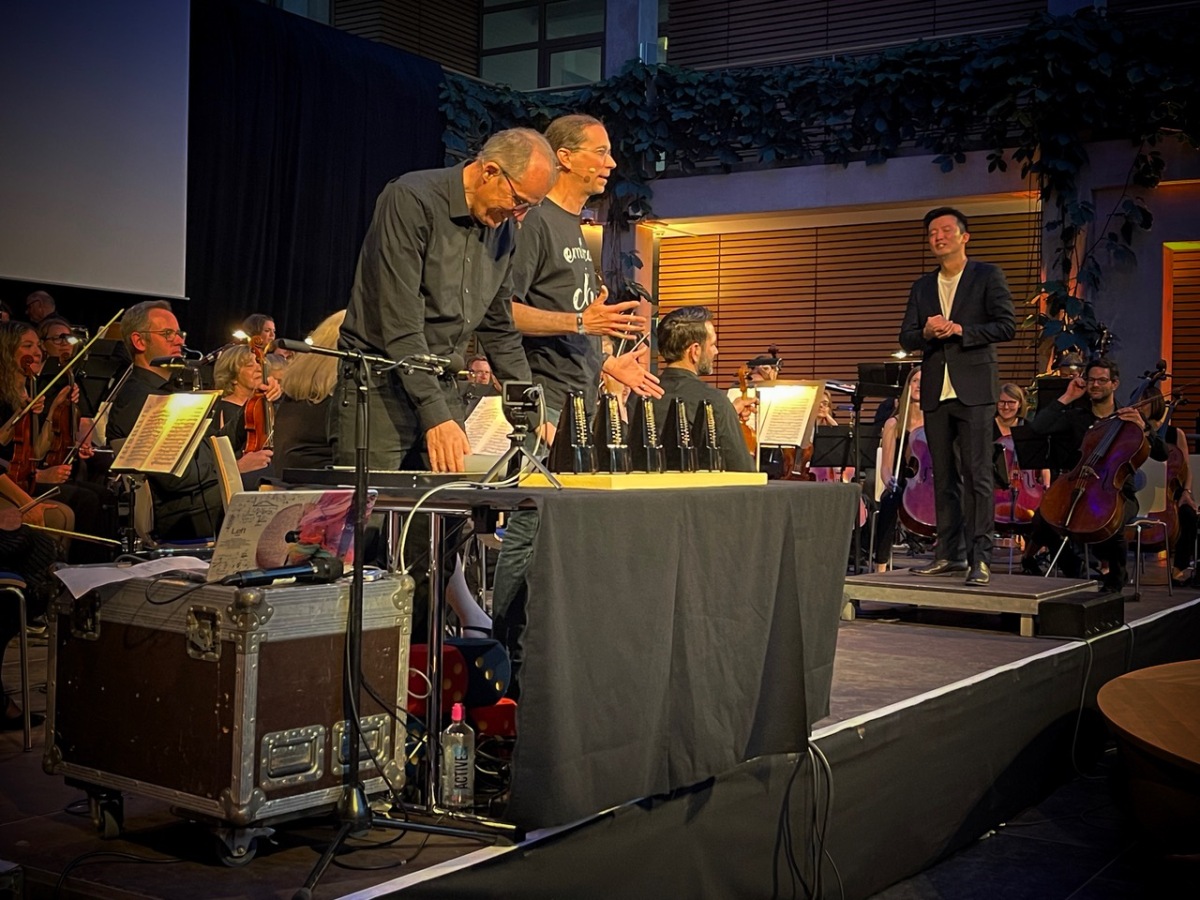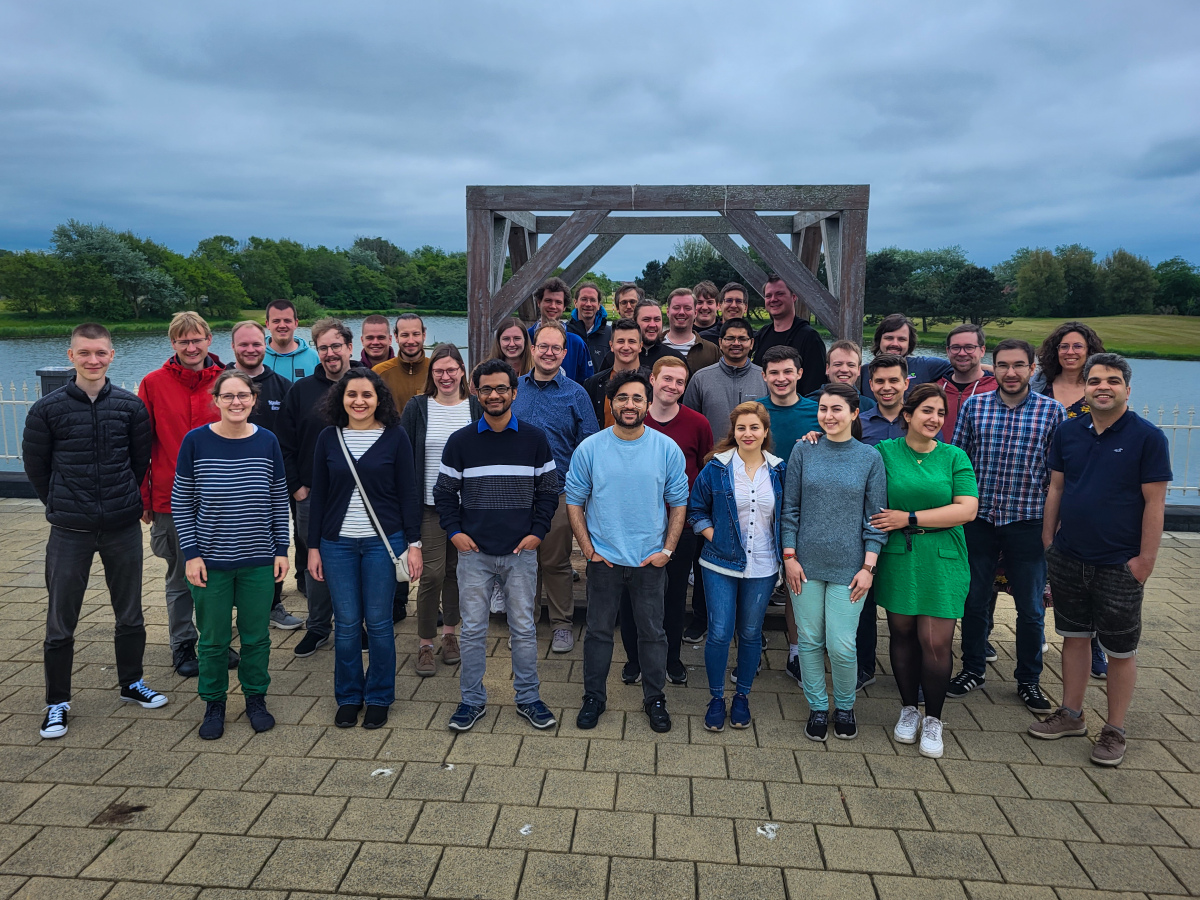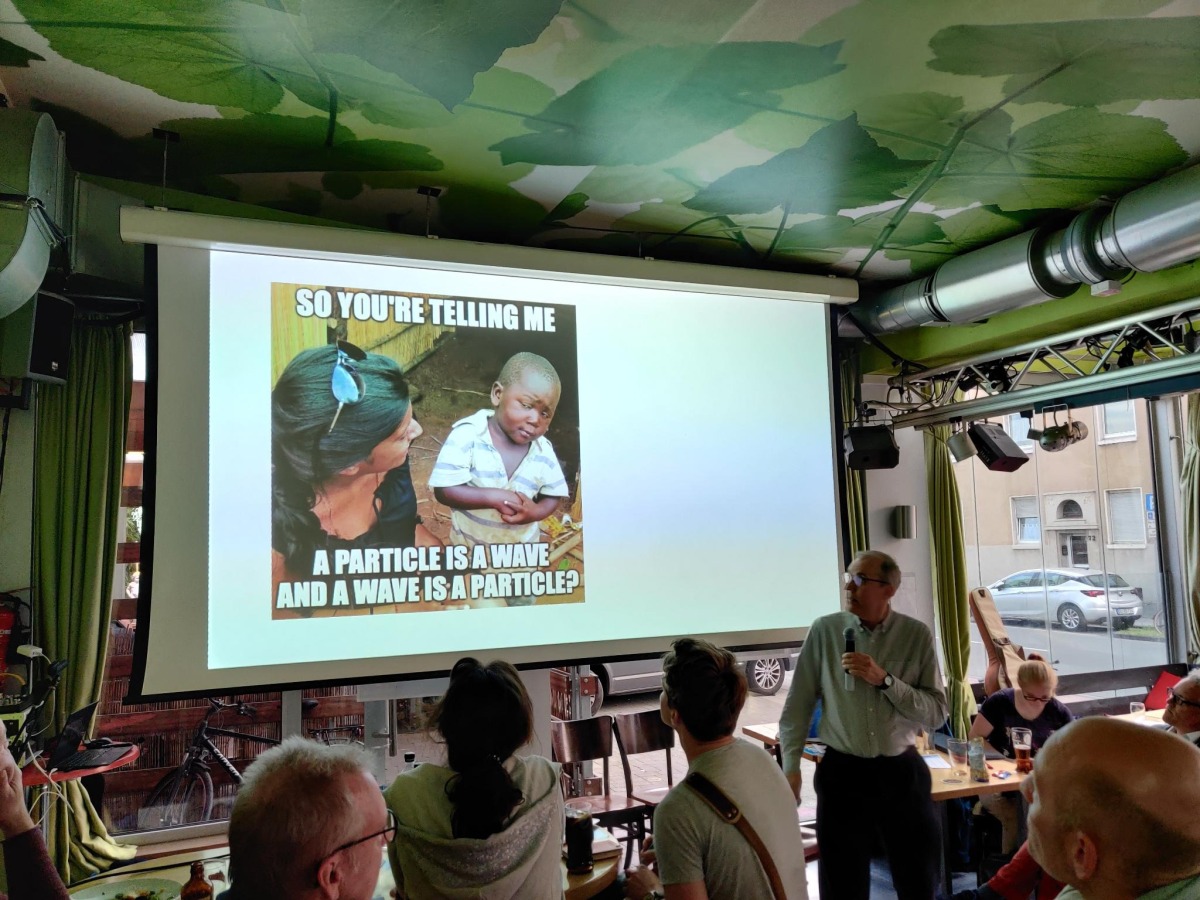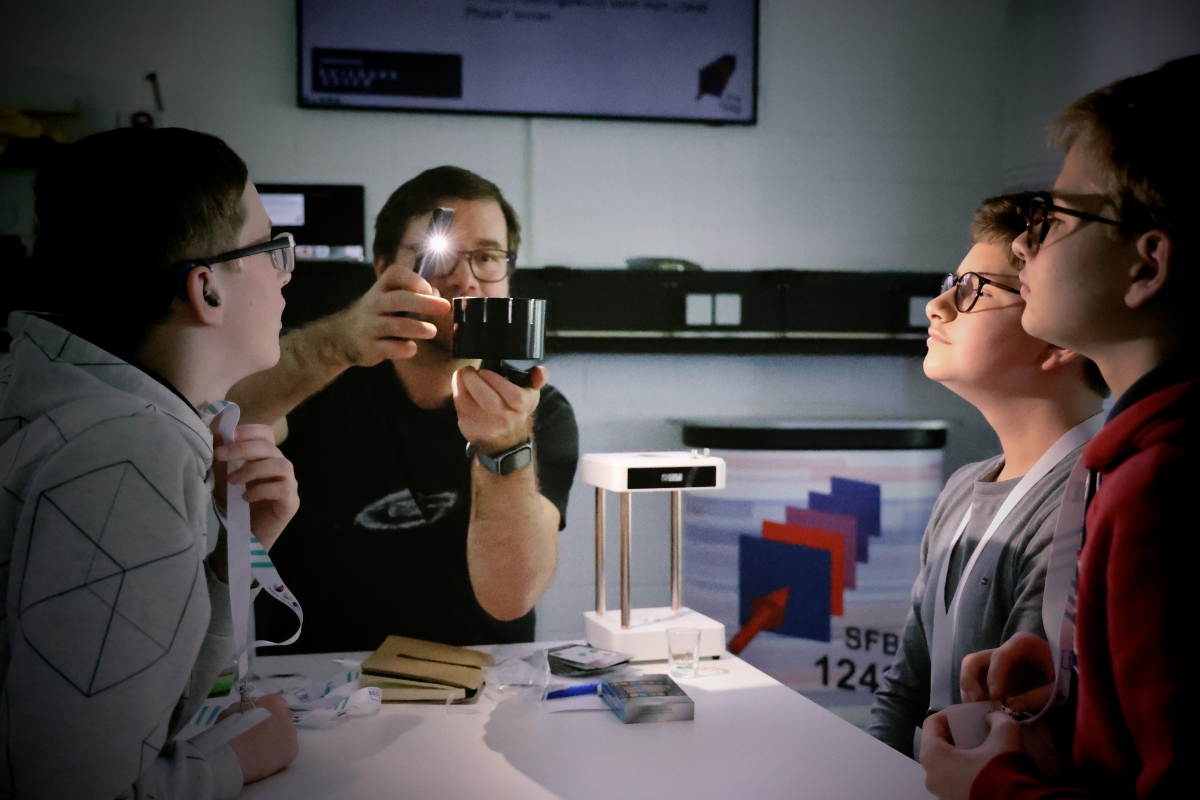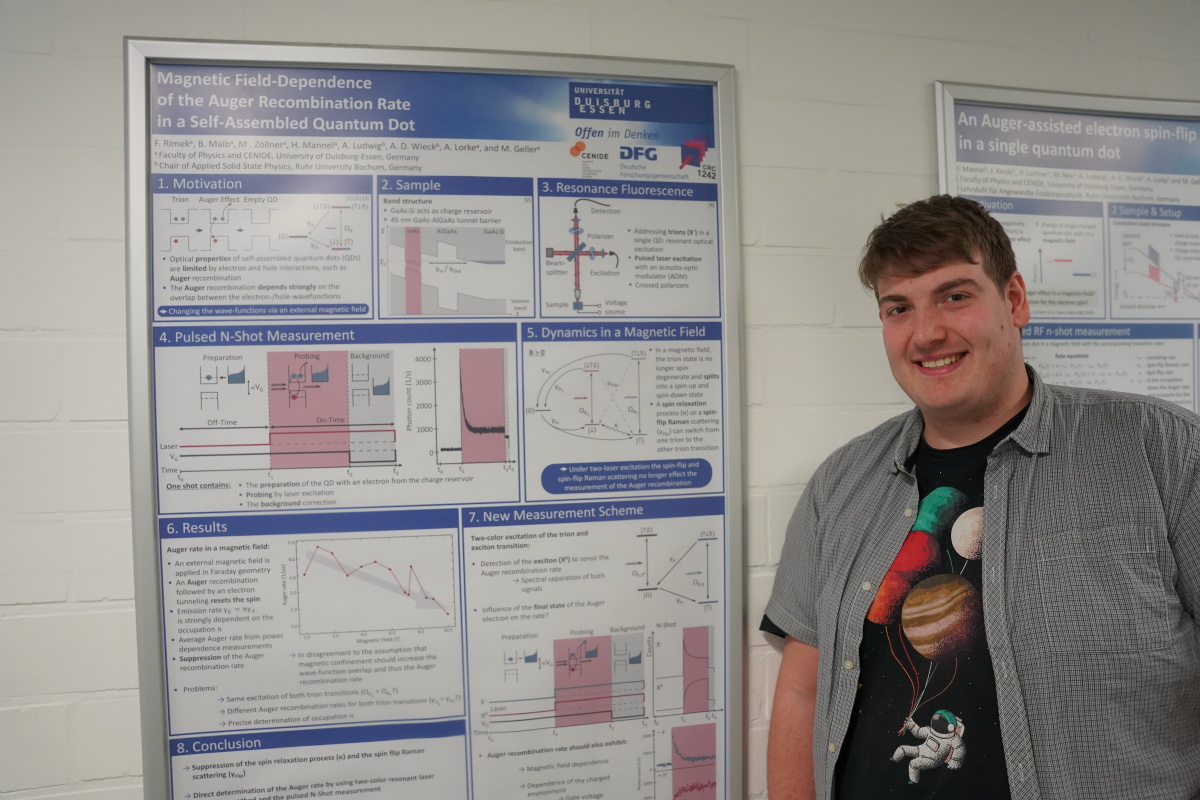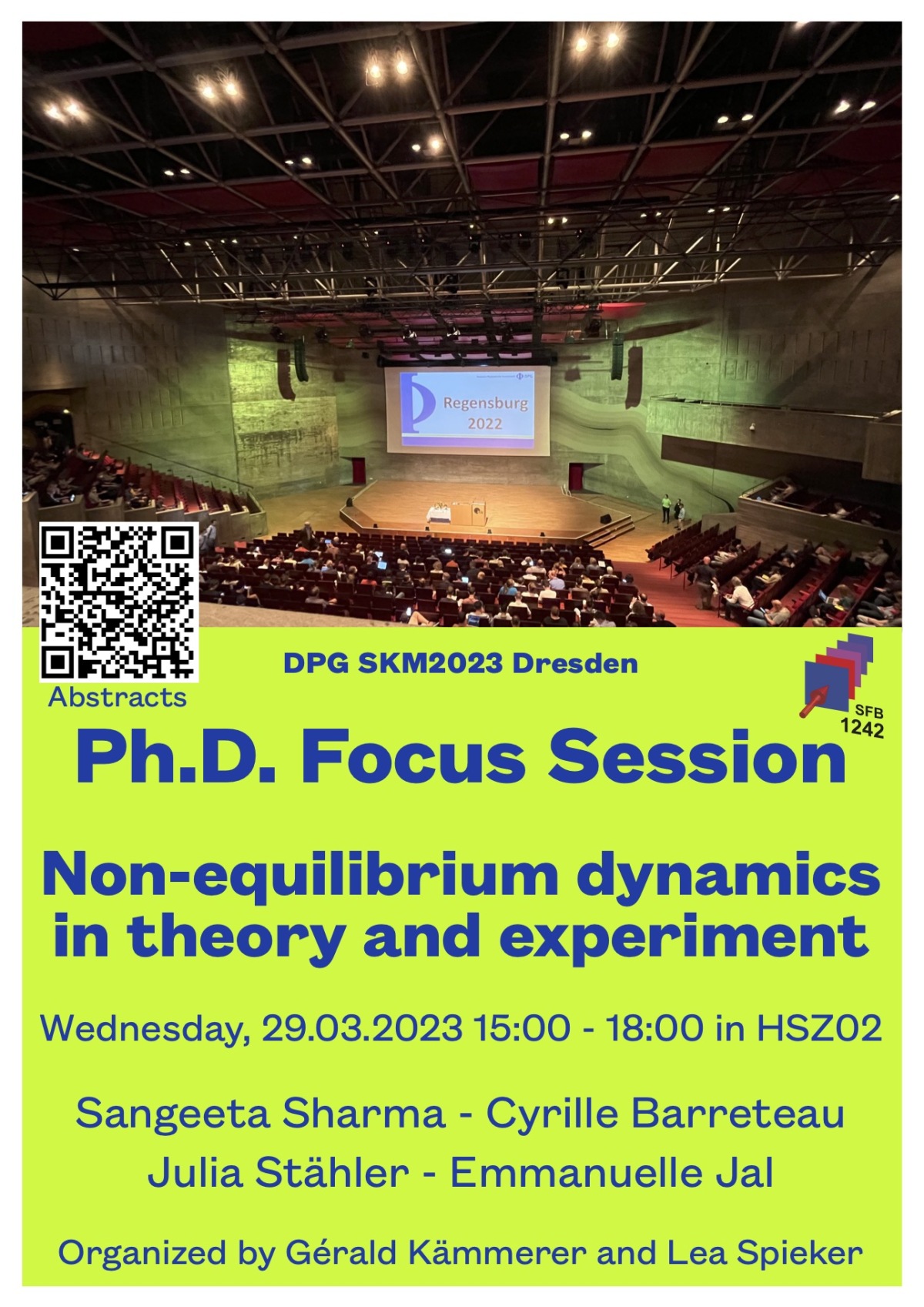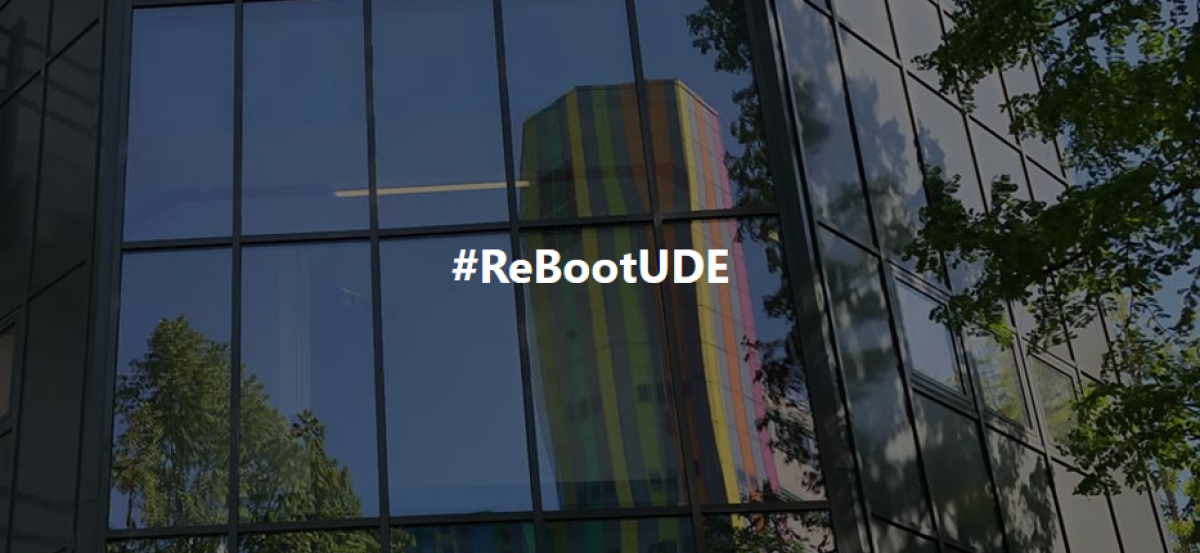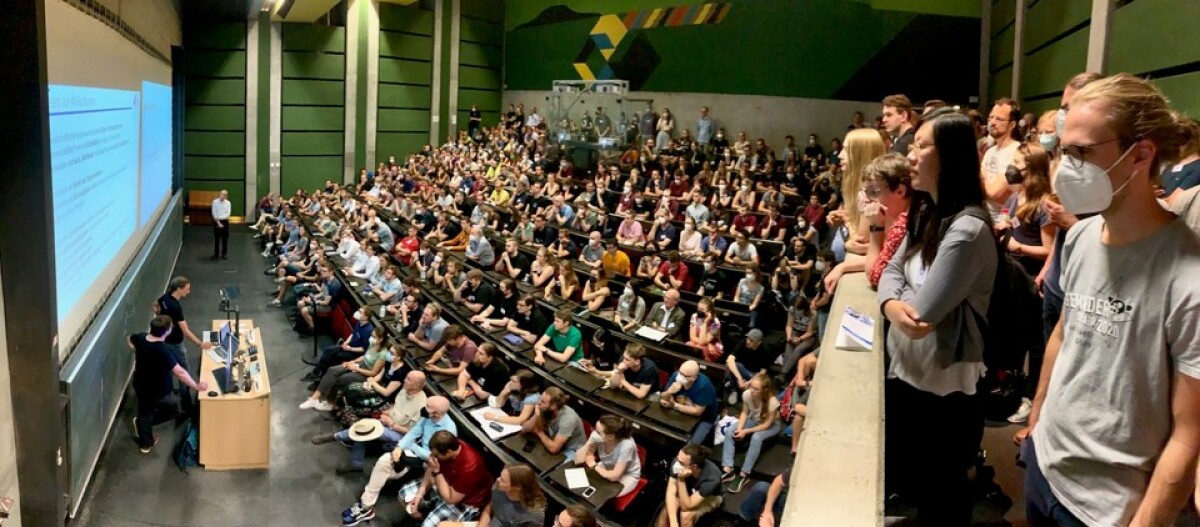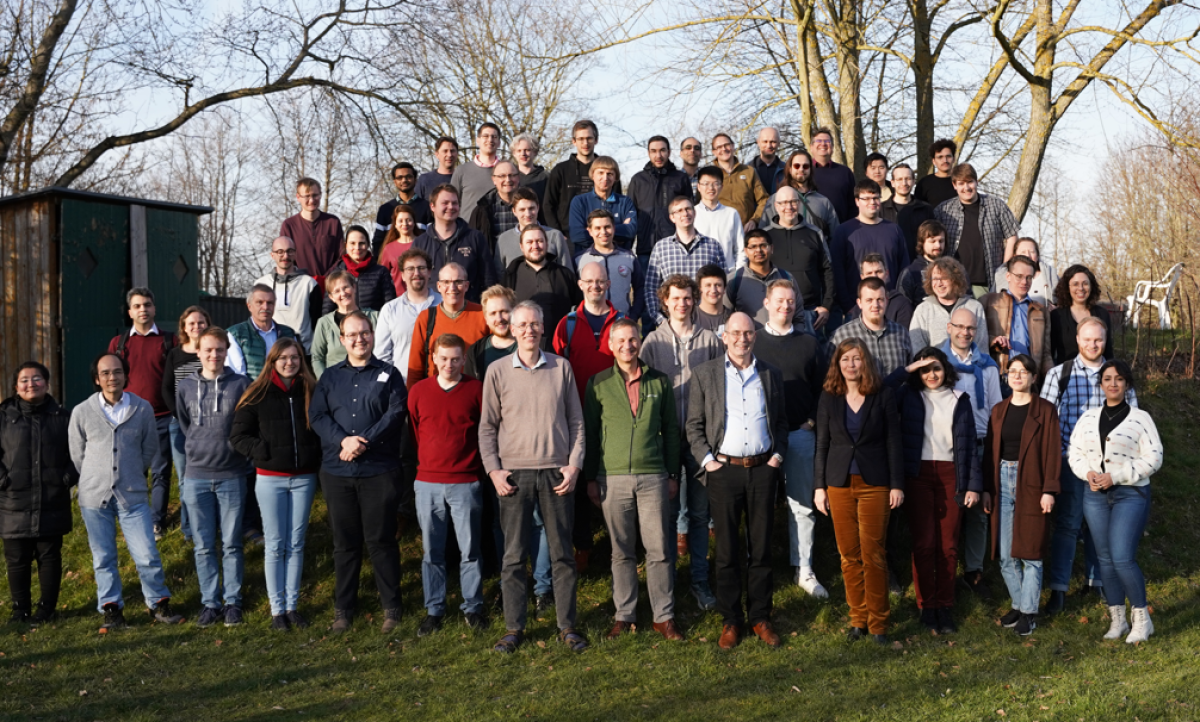News from the CRC 1242
Night of Physics in Duisburg
On November 21, starting at 5 p.m., the Faculty of Physics at the Campus Duisburg opened its doors. Children and adults could try out experiments, visit laboratories, and discover how exciting science could be in everyday life until 11 p.m, while UDE researchers sparked curiosity and enthusiasm for physics. Throughout the evening, the CRC1242 research laboratories were open to the public, and starting at 7 p.m., UDE physicists gave lectures on the core topics of physics – from space to the quantum world. Anyone who wanted to start studying after being amazed found advisors in the foyer for physics, physics teaching, and energy science. Professors and students talked about their everyday lives, explained the buddy system, and answered questions about applications, the course of study, and career prospects—without any formulas, but with a lot of enthusiasm.
Hertha Sponer Prize 2026 – Physicist Maria Azhar honored
Dr. Maria Azhar is being honored with the Hertha Sponer Prize from the German Physical Society for her research in the field of topology in magnetism. She joined the UDE as a postdoctoral researcher in August 2023 and continued her outstanding research work in the field of topological 3D magnetic structures in Prof. Karin Everschor-Sitte's “TWIST – Topological Whirls In SpinTronics” working group and has further advanced the understanding of topology in magnetism, complex magnetic phases, and their possible applications. For this and further research contributions, she has now been honored by the jury of the Hertha Sponer Prize of 3.000 € and a certificate: Maria Azhar already provided fundamental insights into non-collinear magnetism during her doctoral studies and predicted screw dislocations in helical magnets in further work. Dr. Maria Azhar will be presented with both during the 89th Annual Meeting of the German Physical Society in Erlangen on March 17, 2026.
Science Slam in Duisburg
On October 30, scientists from the university presented their projects in an entertaining way on stage at the Bora in Duisburg—in a way that was easy to understand and full of humor. Whoever convinced the audience won the applause and the title of best science slammer.
Everyone was able to see for themselves how well research and entertainment go together: Researchers from various disciplines showed why working in the laboratory or at a desk can be more entertaining than one might think. The event was supported and coordinated by the Faculties of Engineering and Physics (Dr. Nicolas Wöhrl) and the Center for Fuel Cell Technology (ZBT) (Dr. Theresa Schredelseker).
Quantum stochastic resonance in a single-photon emitter
Researchers at the University of Duisburg-Essen have demonstrated that the random noise caused by the quantum mechanical tunnel effect can be specifically controlled—a phenomenon that is also focused by this year's Nobel Prize in Physics. In a collaboration combining experiment and theory, the research groups led by Prof. Dr. Axel Lorke and Prof. Dr. Jürgen König have succeeded in observing stochastic resonance in a quantum phenomenon. In stochastic resonance, small random fluctuations amplify what is actually a weak signal, making it clearer and more pronounced. Using high-resolution laser spectroscopy, the research groups tracked the movement of a single electron between a quantum dot and an electron reservoir, separated by a barrier that can be randomly crossed due to the quantum mechanical tunneling effect. A small alternating voltage tamed this source of noise for the electron movement, allowing the electron to oscillate much more regularly between the quantum dot and the reservoir. The results, now published in Communications Physics, open up new perspectives for future quantum devices.
Resolving the polar interface of infinite-layer nickelate thin films
UV light at the interface between two oxide materials can be used to switch an extremely conductive state on and off – in a matter of seconds. This newly discovered “light switch for electrons” marks a milestone on the road to light-controlled electronics and could also be used in future superconductors. Prof. Dr. Rossitza Pentcheva and her former colleague Dr. Benjamin Geisler (University of Florida) are part of the international team. The study focuses on NdNiO₂, a representative of the so-called infinite-layer nickelates. This class of materials is similar to high-temperature copper oxide superconductors and has gained importance in recent years because it can become superconducting itself under certain conditions. They irradiated the interface with ultraviolet light and simultaneously measured the electrical conductivity. At the same time, Geisler and Pentcheva performed quantum mechanical simulations on the UDE supercomputer, which allowed them to precisely describe the behavior of the electrons. With light as a stimulus, the electrical resistance decreases by up to a hundred thousand times. This is made possible by a tiny electric field at the interface, which collects the electrons released by UV light in an ultra thin layer, as if on an invisible rail. There, they form the conductive electron gas and move particularly easily. As soon as the light is switched off, this state disappears completely – the material returns to its initial state. (Image generated with KI)
Concert celebrating 100 years of quantum mechanics
To honor the 100th anniversary of the discovery of quantum mechanics, visitors of the Campus Duisburg on October 5 were invited to a program full of energy and color: impulsive rhythms and dazzling sounds transported them into the visible and invisible quantum world. What does this world look like? And what does it have to do with our everyday lives? Musically, the Hamborn Abbey Wind Symphony approached these questions with specially arranged compositions – but also with popular melodies, such as those from Aladdin or Star Wars. Prof. Dr. Axel Lorke and Dr. Nicolas Wöhrl guided the audience through the program from a scientific perspective. With vivid experiments and a touch of humor, the two physicists from the University of Duisburg-Essen provided insight into the world quantum physics.
Türen auf mit der Maus 2025
The “Türen auf mit der Maus” (Open Doors with the Mouse) event, which was held under the motto “SpielZeit” this year, takes place annually on October 3. This time, more than 850 institutions nationwide opened their doors. The University of Duisburg-Essen also participated with four exhibits. Scientists from the fields of engineering and physics (Duisburg), technical chemistry, the 3D printing laboratory of the Co-Creation Lab Product Innovations, and the Erwin L. Hahn Institute for Magnetic Resonance Imaging (Essen) explained their exciting research to children, young people, and adults. Building their own ships and learning how strong steel really is, playing with atoms, racing small hydrogen cars against each other, going on a scavenger hunt through the 3D printing lab, watching how the brain thinks, and getting to know the strongest magnet in the surrounding area—many dedicated employees in faculties, institutes, laboratories, and workshops turned the holiday into playtime.
Physikerin der Woche: M.Sc. Newsha Vesalimahmoud
Newsha is a PhD student in physics at the University of Duisburg-Essen. She is part of the CRC 1242, working within Project A07, led by principal investigator Dr. Andrea Eschenlohr.
Her research focuses on how molecular adsorption influences electronic and optical properties. As a model system, she uses FeOEP (Iron Octaethylporphyrin) molecules adsorbed on a Cu(001) surface, which is prepared in an ultra-high vacuum (UHV) system. These molecules are ideal for studying ultrafast and surface-specific dynamics, and potentially relevant for future applications in molecular electronics. To probe these interactions with high sensitivity and surface specificity, she employs second harmonic generation (SHG). This nonlinear optical technique enables her to detect changes in symmetry and charge distribution at the interface.
Summerschool 2025
This year’s Summer School 2025 was successfully held in Burbach from September 8 to 12. We had the opportunity to welcome Gabi Schierning, Michelle Johannes, Michael Lorke, Annika Kurzmann, Dominik Juraschek, Tom Murphy, Joel Cox, Fred Hucht and Michael Horn-von Hoegen, who gave interesting talkes about Phase Transitions, Quantum Dynamics, Nonlinear and chiral phononics, Plasmons and Topological surface effects.
New insights for defect-free layers of semiconductor material
Solar cells and computer chips require silicon layers that are as perfect as possible. Any defect in the crystalline structure of a silicon wafer increases the risk of reduced efficiency or malfunctioning switching operations. A thorough understanding of how silicon atoms arrange themselves into a crystalline lattice on a thin surface provides fundamental insights into the control of crystal growth. A research team from the Helmholtz-Zentrum Dresden-Rossendorf (HZDR), the University of Duisburg-Essen, and the University of Alberta in Canada analyzed the behavior of rapidly cooled silicon. Their results show that the cooling rate has a significant impact on the structure of silicon surfaces. The underlying mechanism likely also played a role in phase transitions during the early universe, shortly after the Big Bang.
Joining the Summer University
A total of 20 students participated at the SUNI. Karin Everschor-Sitte's working group from the CRC 1242 was also there with a presentation “Für Wirbel sorgen – Vom Magnetismus bis zur Professur” and a hands-on programming workshop entitled “Spinfluencer gesucht – Magnetische Muster simulieren”.
Dr. Katharina Ollefs starts professorship at Heidelberg University
The Faculty of Physics congratulates Katharina Ollefs on her W3 professorship in solid state physics at Heidelberg University. She started her new position on August 1, 2025. Katharina Ollefs studied physics at our faculty from 2003 to 2008 and received her doctorate in 2012 in Prof. Dr. Michael Farle's research group. She was principal investigator in SFB/TRR 270 HoMMage and, from 2020, both project manager at SFB 1242 and a member of the executive board. Fortunately, this did not prevent her from having two children.
We wish her all the best!
Playing for the U20 national basketball team and studying physics at the same time? Maja Manten is mastering this challenge!
Physics student Maja Manten will be playing for the U20 national team at the European Basketball Championship in Portugal on Saturday, August 2, 2025. In addition to training for this and playing as center for the second division team New Basket Oberhausen, she is also studying physics at the University of Duisburg-Essen and works as a student assistant for the CRC 1242. She has just submitted her bachelor's thesis to Prof. Dr. Frank Meyer zu Heringdorf – while she is still on the U20 team! “The biggest challenge is definitely time management – coordinating training, games, and classes needs good planning.” Many professors are apparently understanding her situation. "For example, they allow me to be flexible with classes that require attendance or to schedule the start of my bachelor’s thesis to fit in with the national team’s summer schedule." All that remains is to wish her lots of fun and success!
Demanded expertise – DFG elects Marika Schleberger to committees
Her expertise is highly respected: The German Research Foundation (DFG) has now elected UDE physicist Prof. Dr. Marika Schleberger to the Senate and Approval Committee for Research Training Groups (GRKs). Schleberger, who has been researching and teaching at the UDE since 2002 (back then the University of Essen), will join the committees on January 1, 2026.
A total of 39 scientists are members of both committees. In future, she will therefore be involved in which proposals the DFG approves in its GRK funding programme. She is the long-term vice spokesperson for the Integrated Research Training Group of the UDE's Collaborative Research Center 1242 and a member of the board of the International Research Training Group 2D-Mature, a joint program between the UDE and the University of Waterloo.
“GRKs are of strategic importance for universities because they reflect current research priorities,” explains Schlebeger. “I think it's essential that there are specifically tailored programs that enable doctoral students to conduct excellent research and gain qualifications without overburdening them in terms of time.” She is now looking forward to getting to know GRKs from other disciplines as well.
FISU World Conference – Information Stands with Experiments on König-Heinrich-Platz
On July 21, 2025, directly in front of the theater on König-Heinrich-Platz in downtown Duisburg, there was more than just a swimming pool and a beach bar. Several interesting information stands were also set up. The Faculty of Physics, including SFB 1242, was on site with several experiments, including a fountain where the drops seemed to fall upwards. In addition, there was an interesting mix of other stands: from the zdi center, where visitors could make running brushes that they could then take home with them, to a criminal case, the solution to which was rewarded with ice cream at the "Quantum Materials" stand. The robot dog from Boston Dynamics at the mechatronics booth, which was always "sniffing around" somewhere or looking for something to fetch, was probably the most popular attraction for a selfie. Overall, it was a great opportunity to showcase what is happening at the University of Duisburg-Essen in the center of Duisburg. This opportunity was particularly popular with families with children.
Girl's Day
Department: Experimental Physics at the DUISBURG Campus, Collaborative Research Center 1242: Experiments in the fastest laboratory in the world.
Light takes about one second to travel from the moon to the earth. In the same time, it can orbit the earth more than seven times. So light is (almost) infinitely fast. But exactly how fast is it? We will determine this experimentally together in the laboratory. We will also show you how we use light in the laboratory. Did you know, for example, that super-fast light can also slow down processes? We can even (apparently) use light to stop time or make it run backwards. During your visit to our Collaborative Research Center 1242, we will show you why this is not only amazing for you, but also for cats.
On Girls'Day - Girls' Future Day, a diverse program awaits you at the University of Duisburg-Essen from 9 a.m. to 1 p.m. with lots of information about our STEM degree programs and creative careers.
Colorado Adventure: PhD student Hendrik Mannel visits NIST in the USA
Our doctoral student Hendrik Mannel is currently in the USA for an extended research stay. Here he tells us a few things about his impressions:
Boulder is a really 'livable-worthy' city in the USA. It has a lot of public transportation (for the USA), so it's easy to get around without a car. The people here are committed to climate protection and the environment, all in all a fairly European city. There is also a lot of esoterica, which you can notice in the stores in the pedestrian zone in the city center. But because the city is so livable, more and more rich people are also moving in here, and there are really huge villas and a remarkable number of Cybertrucks...
At the beginning, I didn't have a pass for the Nist, the research institute where I work. That's why I had to go to the visitior center every time, show my passport and go through a metal detector to be able to enter the Nist at all, only with an official guard. The longer-term ID card required further checks of my identity, my residence permit and the data stored in the Nist. As this is a federal government facility, they take security very seriously.
The Nist in Boulder has a huge 'clean room' where the US standard volt is produced. This clean room has everything you could ask for and can produce some pretty advanced equipment and samples. First of all, a new waver with quantum dot molecules was produced for me and interdigital transducers were created on it that can generate surface waves. I can now examine this sample optically. The optics lab is also really well equipped with lots of different lasers and single photon detectors.
In the meantime, I had to apply for a social security number and open a bank account to get some financial support from the Nist, but that went smoothly. The people here are super nice and it's really easy to take public transportation to the Rocky Mountains to go skiing. You can also go hiking in a beautiful winter wonderland.
Physikerin der Woche: M.Ed. Ann-Sophie Meyer
Ann-Sophie is a PhD student in Marika Schleberger's group at the University of Duisburg-Essen. She received her Master of Education in mathematics and physics with the goal of becoming a teacher. However, after completing her degree, she decided to embark on a research career and her doctorate in physics. As part of the CRC 1242, her research focuses on ultrafast non-equilibrium dynamics in condensed matter, particularly through time-resolved ion-induced photoelectron emission spectroscopy.
Simulations predict that the interaction and relaxation processes within the electronic and phononic systems following an ion impact occur on timescales ranging from sub-picoseconds to nanoseconds. Experimentally verifying these dynamics, however, poses a real challenge due to the precision required to pinpoint the ion impact in time and the creation of a suitable (sub-)picosecond ion pulse. Within the framework of Project C05 of the CRC 1242, such a source has been developed, enabling the creation of picosecond ion pulses via femtosecond photoionization of noble gas atoms.
Building on this achievement, Ann-Sophie is conducting the world ́s first pump-probe experiment using ions as a pump source. Her work investigates ion-induced non-equilibrium dynamics in solids, providing unprecedented experimental insights into these processes. This research represents a groundbreaking step in understanding the fundamental ultrafast dynamics triggered by ion impacts.
Kick-off meeting of the CRC 1242 in "Bergisches Land"
At the beginning of February, our entire CRC, PIs and PhDs came together for a kick-off meeting as part of the start of the third funding period. Scientific plans were intensively discussed, talks were given and posters were presented. The meeting took place within the impressive walls of the Kardinal-Schulte-Haus in Bergisch Gladbach. There was also something to celebrate: Frank Meyer zu Heringdorf was able to report on a publication in the journal Science.
Pascal Dreher's work is featured on the cover of Advanced Photonics
Pascal Dreher not only has the pleasure of a recent publication, but also the honor of having his research on the cover of the journal "Advanced Photonics". We congratulate him on his success. Click here to go directly to the publication.
St. Nicholas pub quiz at the CRC Christmas party
After practicing the format of a STEM pub quiz on the MS Wissenschaft a while ago, this time we were invited to support our internal Christmas party with scientific entertainment. Not only did we have a lot of fun preparing and moderating, but the participants were also very satisfied. The lucky winners came from the AG Schleberger, congratulations again from our side.
Ionenstrahlworkshop goes Duisburg
Our PI Lars Beuer hosted the National Ion Beam Workshop in Duisburg from 30.09.-02.10.2024. After a long break, the community was able to come together again to present their latest research results and discuss current developments. We are looking forward to the next time!
Science meets sound
He normally works with terahertz radiation and two-dimensional materials. On Sunday, September 15, Prof. Dr. Martin Mittendorff, will be on the stage of the Mercatorhalle for the Duisburg Philharmonic Orchestra's first chamber concert: Starting at 6 p.m., he will introduce the auditorium to the “Energy” concert with a lecture.
Both the Duisburg Philharmonic Orchestra and cellist Tetzlaff herself are involved in the Orchestra of Change, a network of German professional orchestras and individual musicians who are jointly committed to climate protection. The Duisburg Philharmonic Orchestra has been involved from the very beginning; forty German orchestras have now joined the initiative.
Together with the Orchester des Wandels, the Duisburg Philharmonic Orchestra will be hosting lively discussions on the topics of energy, climate protection and sustainability in the foyer before and after the concert.
Further information can be found at
https://duisburger-philharmoniker.de/Konzerte/energie-kako01-2024-2025/
Prof. Dr. Martin Mittendorff, Experimental Physics, Tel. 0203/37 9-2273, martin.mittendorff@uni-due.de
SPA-LEED Workshop
International Workshop on LEED and related techniques, TU Chemnitz, Germany
Diffraction from surfaces of crystalline matter provides information on surface structure and morphology which otherwise is not available from microscopic techniques like scanning probe techniques. Employing the capabilities of high-resolution low energy electron diffraction (LEED) for the analysis of spot profiles enables the study of strain state, island size or domain width distributions, and diffuse intensity originating from point defects or phonons.
The international SPA-LEED workshop 2024 took place in Chemnitz from October 9-11. The SPA-LEED workshop has a long-standing tradition and has been held regularly since 1985. Around 50 national and international scientists working in the field of surface and solid state analytics were particpating. The broadband research activities in this filed were demonstrated by 5 invited and 12 contributed lectures as well as 20 poster presentations.
Special emphasis was given to the yet unsolved mystery of the “bell shaped contribution” which is present in LEED from many 2D-materials. Prof. M. Tringides introduced this topic, which was subsequently lively discussed by the participants. A likely explanation was presented by M.Sc. B. Finke through the scattering of electrons with the vertically polarized ZA-phonon mode of the 2D-layers.
Measurements in the time domain allow access to structural dynamics subsequent to impulsive optical excitation of the surfaces. This has been impressively demonstrated by Dr. T. Domröse for a driven phase transition in the dichalcogenide 1T-TaS2. Spot profile analysis allowed him to follow the temporal evolution of the domain size with ps resolution during the recovery of the ground state. Dr. C. Brand demonstrated the possibilities of diffraction with fs temporal resolution to follow the energy flows in ultrathin Pb layers on Si surfaces subsequent to optical excitation.
International conference 2024
This year, the CRC will once again host an international conference (08/14/2024) to which scientists working on the non-equilibrium properties of materials are invited. These materials are only at the beginning to be understood and hold enormous potential for technical applications. In addition, the continuous miniaturization of devices is reaching the nanometer scale, where quantum effects are increasingly playing a role and phononic states and interface properties influence device performance. Drive materials and the control of energy relaxation, both on ultrashort time and nanometer length scales, are therefore of great importance and are the focus of this conference. Further information can be found here.
SPICE Workshop
The SPICE workshop "Spin Textures: Magnetism Meets Plasmonics," brought together world-leading experts to explore the intersection of magnetic and electromagnetic spin textures. Participating scientists examined how complex electron-atom interactions in solids lead to emergent physical phenomena, such as magnetic spin textures and plasmonic excitations. The workshop focused on the similarities and differences between these fields, highlighting the challenges of realizing tailored spin structures. The event, which took place in July at the Engelthal Monastery in Wasem amidst picturesque vineyards and historic architecture, promoted collaboration to advance research in this innovative field of physics.
The workshop was organized by Maria Azhar, Pascals Dreher, Frank Meyer zu Heringdorf and Karin Everschor-Sitte and the first two gave great overview talks on the respective individual areas. The recordings of the talks and further information are available at https://www.spice.uni-mainz.de/spin-textures-home/. Further CRC 1242 scientists presented posters. The organizers are grateful for the financial support by the CRC 1242, CRC/TRR 270 and CENIDE.
(Nearly) all rockets launch! (Freestyle physics)
It was a pleasure for us again! Having generally beautiful summer weather on July 1st 2024, not too hot and not too cold, we were once again able to welcome over 1000 pupils to our campus for freestyle physics. On five competition days, groups from different schools demonstrated, for example, how to drive a boat with a mousetrap, how to build the best free-kicking machine or how to build a Duisburg harbor crane out of paper. As always, Friday was the highlight of the week, when the self-built water rockets were launched high into the air. The winning rocket was in the air for an incredibly long time until it disappeared behind the tent after well over half a minute. Once again, we were impressed by your constructions and are already looking forward to Freestyle Physics 2025!
DFG continues funding for the third funding period of the CRC 1242
Physics is especially exciting when things are not in equilibrium. A bell in equilibrium simply hangs vertically. If you hit it with a hammer, you hear a sound. What happens to the energy from the impact to the fading of the sound? Understanding processes like this - although on a completely different size and time scale - is the aim of the Collaborative Research Center 1242 Non-equilibrium Dynamics of Condensed Matter in the Time Domain at the UDE. Funding from the German Research Foundation has now been extended once again.
The scale in the Collaborative Research Center (SFB): The hammer is a laser that excites a sample. A second laser pulse interrogates what the first one has triggered or activated. This happens in a fraction of a second. This fundamental research aims to discover and understand new scientific phenomena.
Matter contains atoms and electrons that can be transformed from the ground state into higher energy states - for example by excitation with a laser pulse. In a similar way, condensed matter, i.e. solid or liquid matter, also falls out of equilibrium. A dynamic process starts that leads to exciting changes in the material properties. This is the focus of the investigations of the scientists in the CRC 1242 “Non-equilibrium dynamics of condensed matter in the time domain.
The aim of the scientists is to develop a microscopic understanding across multiple materials of non-equilibrium states over time. The spokesperson of the research network, Prof. Dr. Uwe Bovensiepen, explains: “We will further develop and interlink the methods and techniques of physics in order to describe the entire development in space and time - from the moment of the stimulus through secondary processes to a state close to equilibrium.” An excited system always tries to return to a state of equilibrium. Understanding the dynamic processes could unlock ways to keep materials in a non-equilibrium state and thus make new properties accessible, particularly for semiconductors in computer chips and solar cells.
In the first funding period (2016-2020), suitable research methods were developed and inner-atomic processes were analyzed and described. The second funding period (2020-2024) built on these findings and aimed to manipulate the dynamic processes in non-equilibrium. In the upcoming third funding period (2024-2028), the focus will be on excitations that carry angular momentum. These are, for example, lattice vibrations in which the atoms undergo a circular motion.
Physics to your earsNew SFB podcast provides insight into the Collaborative Research Center
[20.12.2023] A little (early) Christmas present for us and you: The new SFB1242 podcast is now online. In the first episode, Axel Lorke explains what is hidden behind the complicated name of the Collaborative Research Center and how such an SFB actually works. From now on, we will publish new episodes every month. Always on the 12th of the month at 12:42 p.m. Have fun listening.
New publication in PRX EnergyMetal electrons observed as if in flight
[15.11.2023] When sunlight is converted into electricity, energy is lost and efficiency decreases - the solar cell becomes warm instead of delivering electrical power. The same applies to transportation in our electricity grid, where around 6% of the energy used is converted into heat, among other things, and is lost electrically. Computer chips also have to be cooled at great expense so that the unnecessary waste heat does not melt the electronics. One reason for this is the way electrons are transported in a metal wire. These often do not move along a ballistic trajectory, i.e. undisturbed in a straight line, but collide with other electrons, which leads to an inefficient zigzag movement. These collisions distribute the energy between the electrons and the ion hulls and generate heat. Markus Heckschen, together with a number of colleagues from the Collaborative Research Centre 1242, has now been able to analyze the flow of electrons with extremely high time resolution in iron-gold crystal layers in real time and model the scattering processes. A better understanding of how electrons move, combined with further analysis of the interaction between electrons and the crystal lattice, could potentially reduce a lot of waste heat caused by frictional losses in electrical and electronic components.
A crystal made of iron and gold was chosen as the test material. The advantage of these materials is that they fit together extremely well like puzzle pieces and there is no disruptive lattice displacement, which minimizes interface effects. The thickness of the gold layer was specifically altered and high-resolution electron spectroscopy was used to determine how much energy the electrons excited in the iron had lost on their flight through the gold. This required a time resolution of just 0.000 000 000 000 01 seconds. Thin layers and a trajectory transverse to the gold layer enabled the desired ballistic transport, thicker material and diagonal trajectories led to super-diffusive transport, in which there are already a few collisions between electrons, through to diffusive transport, in which electrons collide so often that their original kinetic energy is almost completely converted into heat. The angle of penetration of the electrons also plays an important role here. This knowledge could be used to produce an energy filter that would allow electrons to penetrate the material at the desired angle and thus enable a higher proportion of ballistic transport.
Publication in PRX Energy:
Spatio-Temporal Electron Propagation Dynamics in Au/Fe/MgO(001) in Nonequilibrium: Revealing Single Scattering Events and the Ballistic Limit. Markus Heckschen, Yasin Beyazit, Elaheh Shomali, Florian Kühne, Jesumony Jayabalan, Ping Zhou, Detlef Diesing, Markus E. Gruner, Rossitza Pentcheva, Axel Lorke, Björn Sothmann, and Uwe Bovensiepen. PRX Energy 2, 043009
Publication in Physical Review ResearchEavesdropping on the electron
[08.11.2023] A method developed at the UDE makes it possible to read data from noisy signals: Theoretical physicists and their experimental colleagues have collaborated on this and published their findings in the current issue of the renowned journal "Physical Review Research". The method they describe could also be significant for quantum computers.
You know it from the car radio: the weaker the signal, the more disturbing the noise. This is even more true for laboratory measurements. Researchers from the Collaborative Research Center 1242 and the Center for Nanointegration (CENIDE) at the UDE have now described a method for extracting data from noise.
What is a bit in a convantional computer, i.e. state 1 (current on) or state 0 (current off), is taken over in the quantum computer by the quantum bits, or qubits for short. To do this, they need defined and distinguishable states, but they can overlap at the same time and therefore enable many times the computing power of a current computer. This means they could also be used where today's supercomputers are overtaxed, for example in searching extremely large databases.
In Collaborative Research Center 1242, the smallest structures and their changes are studied, including quantum dots. These nanometer-sized structures can be tailored in their electronic and optical properties in the laboratory. Put simply, their electrons can assume two different directions of rotation ("spin up" and "spin down"). This is how the qubits needed for quantum computers can be realized. These should be stable for as long as possible so that no information is lost. "With our novel technique, we were able to demonstrate that spin states can be specifically prepared and at the same time determine how long such a state is maintained," explains Dr. Eric Kleinherbers, until recently a postdoc in the Theoretical Physics group headed by Prof. Dr. Jürgen König, now at the University of California, Los Angeles.
For this purpose, a quantum dot sample was permanently exposed to an exciting laser and the resulting noise was recorded over a long period of time. The theoretical physicists around Kleinherbers succeeded in extracting the lifetime of the spin states from this apparently random optical signal. Rolf Landauer, a pioneer of information theory, had already predicted this finding in 1998 and summarized it with the phrase "The noise is the signal!" The technique used now makes it possible to re-evaluate even older, seemingly useless data and to discover signals that had previously remained hidden.
Picture: View into the open cryostat: In operation, the slide with mounted sample is analyzed in a vacuum at around -270°C.
Additional information:
Eric Kleinherbers, Theoretische Physik, Tel. 0203/37 9- 3322, eric.kleinherbers@uni-due.de
Editor: Peter Kohl, SFB 1242, Tel. 0203/37 9-2822, peter.kohl@uni-due.de
Nobel Prizes in Physics and Chemistry announced Research on attosecond pulses and quantum dots is honoured
[06.10.2023] The beginning of October is Nobel Prize Week every year. The Nobel Committee announces the laureates, who are awarded annually on December 10 (the anniversary of Alfred Nobel's death). This year, two topics have been selected that the SFB1242 is also working on intensively. The Nobel Prize in Physics goes to Pierre Agostini, Ferenc Krausz and Anne L'Huillier "for experimental methods that generate attosecond pulses of light for the study of electron dynamics in matter". Attoseconds are extremely short, the billionth part of a billionth of a second! Light needs just three attoseconds to move even one nanometre or about 200,000 attoseconds for the width of a human hair. The three researchers created the basis for a new approach to the world of atoms and molecules. In our Collaborative Research Centre, a whole series of subprojects use related ultrafast methods in experiments. Subproject A05 (femtosecond time-resolved spectroscopy in the soft X-ray range for element-specific analysis in complex nanostructures) uses the generation of so-called high harmonics to produce X-ray pulses with extremely short pulse durations, which make it possible to observe excitations in materials virtually in slow motion.
The announcement of the winners of the Nobel Prize for Chemistry followed one day later. Moungi G. Bawendi, Louis E. Brus and Alexei I. Ekimov received it for their work on quantum dots, semiconductor structures also called artificial atoms. This topic is addressed, among others, in sub-project A01, which deals with "Time-resolved electrical non-equilibrium spectroscopy on artificial atoms and molecules".
Uwe Bovensiepen, spokesperson of the CRC 1242, is pleased with the prize winners: "I am particularly pleased with this year's awarding of the Nobel Prizes. We have been using the methods of ultrafast spectroscopy very successfully in our Collaborative Research Centre for many years. Anne L'Huillier is a very respected colleague, as are the other prize winners, and has also been a guest in our colloquium Quantum dots and related nanostructures also play a role in our work. So both Nobel Prizes are very close to the scientific questions we pursue at the UDE." We are currently planning an evening event with lectures on the Nobel Prize topics. As soon as a date has been set, we will announce it here.
Over 300 visitors"Nacht der Physik" invites you to take a look at research
[02.10.2023] On Friday, 29.09.2023, the Night of Physics took place at the Duisburg campus. From 5 p.m., young and old were invited to be whisked away into the world of physics. There was something for everyone: laboratory tours, lectures on a wide range of topics, information stands on studying and research and, of course, lots to try out and take part in.
Anyone who wanted to find out more about airplanes, quantum effects, life on Mars, magnets or photoluminescence could join one or more of the many presentations.
Prefer practice rather than theory? No problem! Of course we were prepared for that: Have you ever seen a maglev train in action? Assembled a "Joule-Thief" yourself with solder? Painted with light? Let a dishwashing brush whizz across the floor? Used a thermal imaging camera or an electron microscope? Of course, there were not only these and many other gimmicks, but the physical effect was also explained directly. Of course, refreshments were also provided in between and so, after a total of 6 hours of knowledge and amazement, the Night of Physics came to an end. We are delighted that so many visitors were there and that some of them chatted with us and the professors and lecturers until the very end and got to know the versatility of physics.
Original text: Jana Schumann
Campaign of the Equal Opportunities Working Group of the DPGLea Kämmerer as female Physicist of the Week at the German Physical Society
[25.09.2023] Since 2018, the Equal Opportunities Working Group of the DPG has featured a female physicist every week - in calendar week 38, Lea Kämmerer (AG Wende, project A05) was in the portrait. Lea works on spin crossover molecules with a focus on the investigation of ultrafast dynamics by using time-resolved X-ray absorption spectroscopy. She has already told us what this means and what her everyday work is like for the SFB podcast, which will start soon. Until the episode with Lea is released, you can read more about her as female Physicist of the Week here:
GANIL PhD Award for Lukas Madauß
[September 2023] Lukas Madauß has won the GANIL PhD Award for his PhD, which he completed in the group of Marika Schleberger at the end of 2021. In his thesis "Structurally modified two-dimensional materials for membrane applications", Lukas worked on the use of 2D materials in membrane applications. Among other things, he bombarded samples with ions at GANIL to increase their porosity. Lukas' work also includes the development of sample preparation methods that we use in project C05.
Congratulations Lukas!
Physics for PhysiciansPaul Geller receives teaching award from the Faculty of Medicine
[20.08.2023] The title of "Best Lecturer" in the first stage of medical training was awarded to Martin Paul Geller this summer. He gave the lecture "Physics for Physicians" to students in the first semester and was evaluated by the participants at the end. We are delighted that the role of physics in medicine and dedicated teaching have been recognized in this way.
Instead of bella Napoli - bella Duisburg!
[August 2023] Marika Schleberger’s working group had two visitors from Italy for three weeks! Thanks to the guest programme of the CRC 1242, Ofelia Durante and Loredana Viscardi from Antonio Di Bartolomeo's group were able to travel from Salerno (near Naples) to learn various steps of sample preparation developed by Stephan Sleziona for the CRC 1242. More specifically, the two, also with support of Osamah Kharsah and Leon Daniel, made pn junctions from black phosphorus and MoS2, learning all the process steps from MoS2 growth to photolithography (for electrical contacting of the pn junctions). We are looking forward to exciting results on these samples and a continued successful cooperation between our two groups.
Publication in Physical Review ResearchNew world record: shortest ion pulse only 18 picoseconds long
[16.08.2023] The work on the ps ion source in project C05 has now made a significant step forward. Our PhD candidate Lukas Kalkhoff was able to demonstrate that the ion pulses generated with the new source are only 18 picoseconds short! This is another order of magnitude faster than our own previous record by A. Golobmbek et al. with 180 ps. The details can be found in Lukas' paper Phys. Rev. Res. which has now been accepted for publication.
Freestyle physics 2023Which rocket will fly the highest, which car will crash the best?
[19.06.2023] Finally summer, finally (almost) vacations and therefore: finally Freestyle Physics again! Traditionally held in the last full week of school before the vacations, this year we were once again able to welcome over 1000 pupils from almost one hundred schools from all over Germany. Solutions were presented and evaluated over four days of competition. This time, the task was to build a bridge out of shashlik skewers that was as stable as possible but also as light as possible, and in the "crazy race", a means of transportation had to be constructed that could cover a defined distance in one minute - but without tires or wheels! In the crash test, the vehicles were allowed to roll, but were abruptly stopped by an obstacle. Whoever lost the least water from an installed cup was the winner. And as always, numerous water rockets were launched into the sky on the last day. It was a pleasure again and we can hardly wait for next summer.
Concert with the Klangkraft OrchestraBetween order and chaos: science and music
[05.06.2023] Science and music on one stage - can that work? Axel and Nicolas proved it together with the Klangkraft Orchestra. In two sold-out shows in the Volksbank Rhein-Ruhr auditorium, all those involved showed how music and physics can be combined. With spherical sounds, unusual rhythms, familiar melodies, exciting experiments and randomly thrown together compositions, this concert was truly chaotic. Just as it should be.
Retreat by the seaPhD Retreat 2023 in the Northern Netherlands
[01.06.2023] Sometimes the usual university premises should be left behind for learning and teaching. Once a year, the PhDs from the Collaborative Research Center retreat to the PhD retreat to talk about their research and their doctorate and to gain new impetus in workshops. Nicolas and Peter gave a two-day workshop on social media and science communication, Gérald Kämmerer spoke on artificial intelligence and a third workshop dealt with the topics of time and team management.
Pint of ScienceWith a cold drink to science
[30.05.2023] Science out of the university and into the city. What we do again and again with our events is a tried and tested concept at Pint of Science. Scientists around the world get out of the lab and into the pub in May to talk about their research. Duisburg also took part for the first time with two events. The topics were very different and covered a broad spectrum on the first evening, "Real, virtual and false realities - urban living spaces, fake news and virtual exhibitions", with presentations from medicine, the Learning Lab and the Chair of Psychological Research Methods. The second evening was entitled "On a small and large scale - from materials and energy sources of the future to the foundations of our world" and dealt with hydrogen, the production of electrodes and Axel Lorke spoke on quantum mechanics.
Light and laser"Junioruni" Essen visits the school lab
[24.05.2023] Can we stop time with light? Why do we need lasers in the laboratory? How is the world's fastest movie made? We used various experiments to get to the bottom of these questions when ten schoolchildren visited our "fastest laboratory in the world". And it wasn't just us who asked questions that day, but also the young scientists. It's always great for us to experience this curiosity. If you would like to visit our school lab, please register for a visit at schuelerlabor@sfb1242.de
Research on self-organized quantum dotsFabio Rimek wins poster prize at DPG Spring Conference in Dresden
[03.03.2023] At the Spring Meeting of the German Physical Society in Dresden in March 2023, Fabio Rimek won first place in the poster competition with his poster "Magnetic Field-Dependence of the Auger-Recombination Rate in a Self-assembled Quantum Dot". Congratulations, Fabio.
DPG spring meeting in Dresden: Ph.D. Focus SessionPh.D. students present Focus Session on non-equilibrium dynamics
[22.03.2023] The Ph.D. students Lea Spieker (AG Wende, project A05) and Gérald Kämmerer (AG Kratzer, project B02) have successfully applied for a Ph.D. Focus Session for the upcoming DPG of the SKM section in Dresden.
In their session, they want to emphasize the gap between theory and experiment on the topic of non-equilibrium dynamics. Four high-class speakers: Sangeeta Sharma, Cyrille Barreteau, Julia Stähler and Emmanuelle Jal will give talks on femtomagnetism, spin-switchable molecules, photodoping and ultrafast magnetization effects. The session will conclude with a podium discussion.
Location and time: 29.03.2023 15:00-18:00 in HSZ 02.
Abstracts can be found here: https://www.dpg-verhandlungen.de/year/2023/conference/skm/part/ma/session/30
Ransomeware attack at the UDEWe are back!
[15.03.2023] At the end of November, a ransomeware attack occurred at the University of Duisburg-Essen. All systems were shut down as quickly as possible and disconnected from the network to prevent further damage. Slowly, step by step, the university is returning to normal operation - and our website is now also available again. We are in the process of adding some information and of course we are also working on new things. Stay tuned!
DPG spring meeting Dresden 2023Focus Session on Science Communication at the DPG spring meeting in Dresden
[06.02.2023] After the DPG is before the DPG. Last year, Project Ö had the pleasure of giving a talk in Regenburg on the topic of "Science communication - for whom actually?" and were delighted at how full the lecture hall became. Project Ö will be back in Dresden in March 2023, this time even with a panel discussion in the lunchtime track with Ulrich Bleyer (Urania Berlin) and Samuel Ritzkowski (young DPG), as well as a whole Focus Session with examples from science communication through invited talks and contributions.
Abstracts can be found here
Preparations for the proposal for the next funding periodCRC general meeting at the Möhnesee
[22.03.2023] "What is the current status, what scientific results have there been in recent years and where do we want to go?" These and other questions were discussed at our CRC exchange meeting at the Möhnesee. Currently, our Collaborative Research Center is in its second funding period - and the application for the third funding period will follow soon. The special thing about this meeting was that the main scientific contributions were presented by the Ph.D. students and so they could present themselves and their work to the other working groups. While the PIs planned the future of the CRC in the second half of the week, the Ph.D. students used the time for workshops and further training on topics such as "storytelling" or "poster design".
News Archive
2nd funding period
2022
| Insights into the beamtime at the synchrotron Bessy II | [18.11.2022] Large research facilities such as particle accelerators, e.g. synchrotrons, are a huge playground for physicists - and unfortunately are usually hardly accessible to the public. For this reason, our PhD candidate Lea Spieker took her camera and tripod with her during one of her last beamtime and lets us share her time at Bessy II at the Helmholtz-Zentrum Berlin for materials and energy. You can watch the video here: SFB on Tour |
| Ph.D. Retreat 2022 |
[25.08.2022] This year, the annual Ph.D. Retreat took place in Schloss Buchenau from 20.-23.06.2022. It covered different areas for all Ph.D. stages: from all-day applicable workshops like "Voice and Speech" and "Work-Life-Sleep-Balance" to workshops for the life after the Ph.D. like "Job Search - Perspectives after the Ph.D." and "Self-reflection: The capability of leaders". In addition, the new Ph.D. spokespersons were elected. Congratulations to Gérald, Fabian, Florian, Jens, Jonas, and Lea. Information on the program, the scope, and the coaches of the workshops can be found on the Ph.D. Retreat 2022 website linked below. A more detailed report on this year's Ph.D. Retreat can be found here. More information on the IRTG itself as well as future events can be found on the IRTG website. |
| The "fastest lab in the world" opens as part of freestyle-physics | [13.06.2022] Making processes visible that are too fast for the human eye: This is not only the topic of our Collaborative Research Centre, but now also part of our newly opened school lab. In experiments that we do together with the pupils, we answer questions like whether you can stop time, what are the properties of light and why we need different lasers in our labs. After our experiments, there will also be a guided tour of the CRC 1242 laboratories. Here you can watch scientists carrying out their experiments. Registration for school classes and groups is now possible at schuelerlabor@sfb1242.de |
| Preparations for Freestyle Physics at the UDE | [25.05.2022] After two years of pandemic break, the anticipation for the finale of Freestyle Physics continues to grow. We were excited to see how many pupils would sign up after two years of online events - and are now overwhelmed by 1400 registrations. Thank you very much for your interest. |
| Beamtime at the European XFEL on the SCS instrument: Time-resolved X-ray absorption spectroscopy of spin-crossover molecules in the ultrafast time regime |
[23.05.2022] Within the framework of the CRC1242, members of the projects A05, A07, and C01 visited the SCS instrument at the European XFEL. There, at the world's largest free electron laser, time-resolved X-ray absorption spectroscopy experiments in the ultrafast time regime were performed on thin spin-crossover molecular films. The characterization of ultrafast dynamics in such molecules is one of the main goals of project A05 in the CRC1242. The group picture shows the staff of the SCS instrument and members of the projects A05, A07, and C01, who are all pleased with the results of the successful beamtime. At present, the data obtained is being evaluated and thus the fruits of the extensive work are being reaped. |
| Support |
[08.04.2022] We provide support for colleagues fleeing Ukraine or facing persecution in Russia. Please contact us! christine.koch@uni-due.de |
| Pushing the limits in real-time measurements of quantum dynamics |
[23.02.2022] Correct counting determines our modern life - whether it is the bits in the computer with their two states, the number of positive corona tests, or in general any system which has countable events. But the faster the counting is done and the smaller the signals are, the more likely data can be lost in the noise. The theoretical physicist Eric Kleinherbers from CRC1242 and CENIDE has now developed a new tool that sheds more light on such data. Counting statistics is especially important in the quantum world. Modern measuring instruments are so sensitive that they can detect single quantum jumps. Limiting factors are the time resolution of the detector, the background noise, and the observation time. The resulting detection errors distort the measured information, so that no or wrong conclusions may be drawn about the underlying quantum dynamics. For their work, the researchers used so-called self-assembled quantum dots, which have similar properties to individual atoms, and employed a trick. The quantum dot is excited with a laser and radiates back light particles (photons) as long as it is "empty." If an additional electron enters the quantum dot, the light current breaks off. In this way, the electron occupation can be recorded in real time by the photons and subsequently statistically evaluated. To test how robust the new evaluation algorithm is, data was deliberately deleted from the original data set, simulating an erroneous measurement. "These were typical experimental errors: signals that are too fast for the detector and are, therefore "missed" or a spike in the noise that fakes a signal" explains Eric Kleinherbers, lead author of the study. By comparing the original readings with the erroneous data, the researchers were able to demonstrate that the new method of analysis is much more error-tolerant than the standard methods of statistical analysis used previously. This makes the actual behavior of electrons and photons more visible, shedding light on the quantum world. "So far, it's a bit like trying to put a screw in the wall with an improper screwdriver," Kleinherbers explains. "It works, but it's not pretty. Now we have the right tool for analyzing the data." Counting statistics is everywhere: in the evaluation of nerve signals as well as in radioactive decay, in microelectronics, and in magnetism. While experimental physicists are constantly coming up with new measurement techniques and experiments, theorists are also pushing the limits of feasibility with new evaluation methods. The developed method is not only interesting for new measurement results - existing data can now also be examined more closely, as Kleinherbers says. "We are in close exchange with colleagues who now want to see what else might be hidden in their data." The results were published in the journal Physical Review Letters (DOI: 10.1103/PhysRevLett.128.087701). |
| New publication about spin-crossover molecules in Chemistry - A European Journal | [22.01.2022] Bi-stable spin-crossover molecules with an abrupt and wide hysteric spin-state switching in the room temperature regime are promising candidates for future molecule-based switching and memory applications. Especially for the analysis of the ultrafast non-equilibrium dynamics in spin-crossover molecules, e.g., with pump-probe experiments which we want to perform within Project A05 in the CRC1242, those criteria are of crucial importance. A joint paper (DOI: 10.1002/chem.202103853), written under the leadership of Dr. Senthil Kumar Kuppusamy (AG Ruben, KIT) within the framework of the Projects A05 and C05, reports two Fe(II) spin-crossover complexes that show these technically relevant criteria and was recently chosen to be a cover feature of Chemistry - A European Journal. |
2021
| Lectures on aesthetics and Non-Equilibrium in the Peschkenhaus | [27.10.2021] What we were missing last year was science communication in front of people instead of screens. Prof. Dr. Axel Lorke and Dr. Nicolas Wöhrl were therefore even more excited to give a lecture on aesthetics in science in the historic Peschkenhaus in Moers. The next good news: on December 2, both will give another lecture on how "Non-Equilibrium moves the world", from the Big Bang to now. We look forward to giving you an insight into the world of Non-Equilibrium and our Collaborative Research Centre 1242. |
| Does Coincidence exist, or does it not exist? |
[25.10.2021] The question of whether there is a true coincidence or whether everything follows a fixed plan is a very controversial topic. Philosophers are not the only ones who investigate this question, physicists also like to deal with it - and it doesn't take many assumptions to show mathematically that coincidence does exist - not only in the quantum world, but also in reality. In the November issue of Spektrum der Wissenschaft, Prof. Dr. Axel Lorke and Peter Kohl show that the throw of a dice is not predictable. Not even if we know all the parameters as precisely as possible such as the height of the drop or the angle of rotation. At this point it should be revealed: coincidence does exist. If you want to learn more about it, take a look at the article here. |
| Fabio Rimek awarded with poster prize at DPG autumn meeting | [11.10.2021] Fabio Rimek won a poster prize at this year's autumn conference of the DPG. This price was awarded for the first time by the Semiconductor Physics Association, for Fabio’s work on self-assembled quantum dots. His poster "Magnetic Field Dependence of the Auger Recombination Rate in a Self-Assembled Quantum Dot" shows, among other things, how quantum dots are affected by strong magnetic fields. The prize is endowed with 100€. Congratulations Fabio! |
| 25th German Female Physicists' Conference | [01.09.2021] From November 8 to 10, 2021 the collaborative research centers SFB 1242 "Non-equilibrium Dynamics of Condensed Matter in the Time Domain" (University of Duisburg-Essen) and SFB/TRR 270 "Hysteresis design of magnetic materials for efficient energy conversion" (Technical University of Darmstadt and University of Duisburg-Essen) established by the German Research Foundation will host the 25th German Female Physicists' Conference. The target group of the digital event is female physicists from various disciplines and career stages - from students to professors, from interns to industrial physicists in top management - and all interested persons.
Further information can be found here |
| Non-Equilibrium moves the world | [08.07.2021] Our world is full of physical movement: Machines are running, wind is blowing, the earth is spinning, trees are growing tall. What drives all this? We know many sources of energy. But what distinguishes a charged battery from a ”dead” one? Where do plants get their energy from? We want to take you on a journey - from the smallest molecules to climate change and the largest galaxies. We want to experiment with you and discuss the question what Non-Equilibrium is and why it moves the world. |
| Thanks to over 50 participants at freestyle-physics@home 2021 | [25.06.2021] In its 20th year after the first event in 2002, the Freestyle-Physics competition for students was held online again this year due to the pandemic. We were pleased to receive more than 50 submissions from which we had to choose the winning videos. It was not easy for us to select the respective winners from the categories Kaleidoscope, Windmill and Crystal Growth. Thank you for your interest and participation. |
| And the winner is ... Minkorrekt! |
[29.04.2021] It is the oldest and most important social media award in Germany: The Golden Blogger. This year, , in the science blog category it went to Collaborative Research Centre physicist Dr. Nicolas Wöhrl and his colleague Dr. Reinhard Remfort, who received his doctorate from the UDE. They got the award for their blog and podcast "Methodisch inkorrekt!", or Minkorrekt for short. "This shows very nicely the growing importance of science communication through blogs," says Nicolas Wöhrl and Reinhard Remfort not only regularly publish a science podcast, but were also - at least before Corona - regularly on German stages, where they are celebrated as "rock stars of science". Until they can perform live in front of an audience again, the physicists have discovered another social media channel for themselves: the live streaming video portal Twitch. Viewers can ask questions during the program or comment on the topics during the show. “It’s especially great to be able to interact directly with the public,” says the scientist enthusiastically. Twitter: Methodisch inkorrekt! Further information can be found here |
2020
| David Janoschka presents video-poster at LEEM/PEEM 11.5 |
During the pandemic, many conferences have moved towards an on-line format. This is also true for the biannular LEEM/PEEM conference, which focuses on low energy microscopy and photoemission microscopy. Ph.D. candidate David Janoschka had the opportunity to present his research on vector microscopy during the on-line conference as a video-poster. Follow the link to see his poster and enjoy a journey into our femtosecond microscopy lab. The complete video can be found here |
| CRC 1242 enters its second funding period |
[01.07.2020] After a funding recommendation of the on-site review panel and a positive decision of the DFG Grant Committee the CRC 1242 is now continuing its effort. We are grateful for the support and the opportunities which lie ahead of us. The complete press release can be found here |
1st funding period
2020
| New Publication About Vector Microscopy in SCIENCE Magazine |
[24.04.2020] The duration of their snapshot relates to one second as one second relates to the age of the universe: In a joint collaboration with Australian Scientist Tim Davis and the Group around Harald Gießen from Stuttgart, Physicists from the Center for Nanointegration (CENIDE) at the University of Duisburg-Essen (UDE) have developed ultrafast vector microscopy as a way of determining electric fields on surfaces with high temporal and spatial resolution. The new method was used to measure the dynamics of optical skyrmions in the time domain for the first time. The renowned journal "Science" publishes this breakthrough in nanooptics in its current issue. Original publication: “Ultrafast vector imaging of plasmonic skyrmion dynamics with deep subwavelength resolution”, Davis et al. (DOI: 10.1126/science.aba6415) |
2019
| Award for Sebastian Schlücker |
[01.10.2019] Prof. Sebastian Schlücker from the Faculty of Chemistry is keen to promote MINT subjects as early as primary school. Together with colleagues, he therefore distributes specially developed experiments with appropriate teaching/learning material. His idea won him 3rd place in the UDE's small business management (sbm) start-up competition. Congratulations! Read more. |
| Smallest measurable processes recorded individually |
[27.09.2019] Colloquially, the term “quantum jump” is used to describe a tremendous development. In fact, it is the smallest change of state that can still be traced. Physicists from the Collaborative Research Center 1242 at the UDE have now succeeded in measuring every single jump by optical means and drawing conclusions about the dynamics of the electrons inside a quantum dot. The journal Physical Review Letters reports on this in its 122nd issue. The experimental setup included a quantum dot – i.e. a solid structure of only about 10,000 atoms – next to a reservoir with electrons. About 100 times per second an electron jumps back and forth between this structure and the reservoir. It can jump into a high or low energy state into the quantum dot and change inside from top to bottom. For the first time, the researchers were able to observe this change through these tiny jumps. |
| Liquid-liquid phase transition in super-cooled phase-change materials |
[14.06.2019] Phase-change materials (PCMs) are used in the latest generation of smartphones enabling higher storage densities and energy efficiency. When an electrical or optical pulse is applied to heat these materials locally, they change from a glassy to a crystalline state, and vice versa. These two different states represent the ‘0’ and ‘1’ of the binary code needed to store information. An international team of researchers led by Klaus Sokolowski-Tinten has now succeeded in observing the processes that occur during switching – something that has never been done before because of the short time-scales involved. They used the ultrashort and extremely brilliant X-ray pulses from an X-ray Free Electron laser to resolve the atomic structure changes of two Sb-based PCMs during the entire switching cycle. They found that two liquid states of the materials are involved in the process – one that has more rigid chemical bonds, and which helps stabilize the glassy “off” state at ambient conditions, and one that is rather metallic and can therefore crystallize very quickly to produce the “on” state. These results provide a microscopic understanding on how PCMs work and why some materials are PCMs and others not. More generally, this work and the applied time-domain approach can also help to understand how liquids of other classes of materials behave when they are rapidly super-cooled to temperatures well below the melting point and why some liquids are more likely to form a glass than others. The study, published on June 14th in Science, was coordinated by the University of Duisburg – Essen and European XFEL and carried out at the Linac Coherent Light Source of SLAC National Accelerator Laboratory (Menlo Park, USA). It was was part of an international collaboration including scientists from Forschungszentrum Jülich, Institut Laue-Langevin, Lawrence Livermore National Laboratory, Lund University, Paul Scherrer Institute, SLAC National Accelerator Laboratory, Stanford University, The Spanish National Research Council (CSIC), University of Aachen, and the University of Potsdam. Original publication: “Femtosecond X-ray diffraction reveals a liquid-liquid phase transition in phase-change materials”, Zalden et al. DOI: 10.1126/science.aaw1773 |
| Dr. Nora Dörmann receives the Diversity Award from the University of Duisburg-Essen | [13.06.2019] Dr. Nora Dörmann has received the Diversity Award of the University of Duisburg-Essen in the category "Managers". The prize was presented on 6 June as part of the Diversity Day by Prorector Prof. Dr. Barabara Buchenau and the speaker of the SFB 1242 Prof. Dr. Uwe Bovensiepen, who also gave the laudatory speech. Mrs. Dörmann is the managing director of the SFB 1242. The prize was awarded in recognition of her commitment to the promotion of women scientists. |
| Focusing Surface Plasmons with Fresnel-Zones | [26.02.2019] In the 19th century, Augustin Jean Fresnel invented his zone-plate; basically a hologram, which - by diffraction - forms a defined focal point if illuminated with a plane light wave. Frank Meyer zu Heringdorf's TR-PEEM Team has now applied the concept of Fresnel-focusing to surface-plasmon-polaritons, i.e., to electron-density waves that can propagate at metal surfaces with almost the speed of light in vacuum. Instead of focusing traveling plasmon waves by a Fresnel type zone plate, however, the team structured particular Fresnel-type grating couplers that were illuminated by femtosecond laser pulses, and that very effectively excited plasmon waves forming a focus at a desired location. Using their time-resolved photoemission microscope, the team could characterize this "Fresnel-optics for surface plasmon waves" in detail, and they could follow the formation of the focus in a super-slow motion movie on the femtosecond time-scale. The results were now published in ACS Photonics. |
2018
| Award of the Sparkasse Duisburg for Outstanding Dissertation | [20.11.2018] Congratulations! Physicist Dr. Philipp Stegmann has been awarded by the Sparkasse Duisburg for his outstanding dissertation on "Generalized factorial cumulants applied to Coulomb-blockade systems", which has been carried out in the working group of Prof. Dr. Jürgen König. In his dissertation, Stegmann developed new theoretical methods for the statistical analysis of charge carrier dynamics in quantum dots and thereby successfully contributed to research activity pursued within the CRC 1242. |
|
Highly Dynamic Solid State Research Prof. Dr. Dmitry Turchinovich joined the CRC 1242 |
[30.07.2018] They are highly dynamic: The microscopic interaction processes inside solids take place on ultrafast timescales. What exactly happens to the electrons and ions in selected cases and how they affect the electrical, optical and mechanical material properties is investigated by Prof. Dr. Dmitry Turchinovich (40) using ultrashort pulses in THz spectral regime: Prof. Turchinovich who has been appointed as professor in Experimental Physics at the University of Duisburg-Essen in 2017 recently joined the CRC 1242 with a new research project. |
2017
St. Peter-Ording
|
[14.08.2017] „Non-equilibrium dynamics“ on the German North Sea coast: About 45 graduate students and postdocs exchanged with national and international researchers and project instructors from the CRC 1242 on current scientific topics from August 7 to 11, 2017 in St. Peter-Ording. In addition to exciting poster sessions, a special highlight was the lecture "Inside Nature-branded journals" by Dr. Luke Fleet, Senior Editor at Nature Physics. |
Dies academicus 2017
|
[29.06.2017] Celebrate the best: At the „Dies academicus“, outstanding scientific performances and the most innovative ideas have been awarded at the University of Duisburg-Essen (UDE). At this year's ceremony on June 28, 2017, the experimental physicist Dr. Tim Frigge from the working group of Prof. Michael Horn-von Hoegen received a prize for his dissertation on "Ultrafast structural non-equilibrium dynamics of the optically excited Si(111)(8x2)->(4x1)-In phase transition". In this, Frigge investigated initial structural dynamics of the photoinduced melting of a charge density wave in atomic chains of Indium on a Silicon(111) surface. |
Doctoral Retreat
|
[10.05.2017] Open discussions between peers to sharing ideas: About 25 scientists are going to meet at the Doctoral Retreat of the CRC 1242 from May 15 to 17, 2017 at „Akademie Klausenhof“ in Hamminkeln. In an open atmosphere lectures, talk sessions, a poster circle and joint activities provide the opportunity to inform themselves about current research and to strengthen the collaboration. |
Report in Nature: Observing Live Phase Transition
|
[30.03.2017] By comparison, a blink lasts a lifetime – atoms can rearrange themselves within one 350 quadrillionths of a second. As reported in the latest issue of the prestigious journal Nature, scientists of the Center for Nanointegration (CENIDE) and the CRC 1242 at the University of Duisburg-Essen (UDE), together with their colleagues from the University of Paderborn, have been able to observe the movement of an one-dimensional material in real-time. Their research confirms that the acceleration of the atoms could leave even a Porsche standing. The complete press release can be found here. |
Science Publication
|
[17.03.2017] Transmitting huge volumes of data and even moving matter using light: These are two of the visions that physicists working in the field of plasmonics have for the future. In a collaboration with colleagues from Haifa (Israel), Kaiserslautern and Stuttgart, scientists at the Center for Nanointegration (CENIDE) at the University of Duisburg-Essen succeeded in producing nanometer-sized plasmon swirls on a metal surface, filming the cycles at 100 attosecond intervals. The video can be found here. The complete press release can be found here. |
UDE: 2D Material withstands extremely high current densities
|
[06.02.2017] The particle penetrated the ultra-thin sample with speeds of up to 450 km/s, yet everything The complete press release can be found here. |
International Symposium
|
[16.01.2017] International symposium on ultrafast soft x-ray spectroscopy and scattering on Friday, 27 January: The Collaborative Research Center 1242 of the Faculty of Physics and the Center for Nanointegration Duisburg-Essen (CENIDE) invite you to attend at the NanoEnergyTechnologyCenter (NETZ) on campus Duisburg. International experts exchange ideas such as how to apply the processes and methods for element-specific analysis in complex nanostructures.
Please find directions and a detailed program here. |
2016
Research into Superconductors
|
[20.12.2016] Below their critical temperature they conduct the electrical current without resistance and thus extremely efficiently: Until now it has only been known that high-temperature superconductors work – but not how. Physicists at the University of Duisburg-Essen (UDE) have succeeded in tracking the redistribution of the energy in the material. To do this they used a medium which is itself fast enough to register these processes – light. The "Nature Communications" journal has just published their results.
The complete press release can be found here. |
Kick-Off-Meeting
|
[25.11.2016] Getting to know each other better, professional exchange and networking: Around 80 scientists met at the kick-off-meeting of the CRC 1242 from 21 to 23 November 2016 in the conference center „Physikzentrum“ in Bad Honnef. Numerous lectures, poster presentations and joint activities such as hiking provided the opportunity to inform themselves about current research and to strengthen the cooperation. External speakers from renowned institutions were also invited.
The complete program can be found here. |
UDE Guided Laboratory Tours on 4.11. and 2.12.:
|
[18.10.2016] Exclusive insights into the laser laboratory of the new CRC 1242 are being offered by the University of Duisburg-Essen (UDE) Faculty of Physics on November 4, 2016 and December, 2, 2016 (17:00, meet at the entrance to the MG building on Duisburg campus). Entrance is free, but registration in advance is necessary as the number of participants is limited. The complete press release can be found here. |
Open Day „WissensNacht Ruhr 2016“
|
[04.10.2016] Exciting labs, amazing lectures and exhibits: during the Wissensnacht Ruhr at the Faculty of Physics and the NanoEnergyTechnologyCenter (NETZ) on September 30, 2016, hundreds of visitors went on a discovery tour through the research activities at the Campus Duisburg. They also got an insight into the CRC 1242 about „Non-Equilibrium Dynamics of Condensed Matter in the Time Domain“.
Selected impressions can be found here. |
Award of the Sparkasse Duisburg
|
[28.09.2016] Congratulations! Physicist Amran Al-Ashouri from the working group of Prof. Dr. Axel Lorke receives one of this year's study awards of the Sparkasse Duisburg for his outstanding study performance. Al-Ashouri is financially supported as a Lab Student within the CRC1242. For years, the Sparkasse Duisburg has been promoting and supporting the scientific work and research of the University of Duisburg-Essen in a variety of ways. As in the previous years, prizes are awarded for dissertations that meet particularly stringent scientific requirements. At the same time, five outstanding study achievements are awarded. |
Major Success for the Faculty of Physics
|
[31.05.2016] The competition was of a very high standard: Numerous groups of researchers applied for a new Collaborative Research Centre (SFB). "In view of the large, nationwide competition, we are very happy that the Deutsche Forschungsgemeinschaft opted for our application", said a very pleased Prof. Dr. Uwe Bovensiepen, Head of the Ultrafast Dynamics at Interfaces group of researchers in the Faculty of Physics of the University of Duisburg-Essen (UDE). "At the same time, this decision confirms our leading role in an important field of physics", explained the future CRC 1242 spokesperson.
The complete press release can be found here. |

